关于举办第二届丘成桐大学生数学竞赛的通知和首届竞赛的有关资料
- 格式:doc
- 大小:120.00 KB
- 文档页数:20
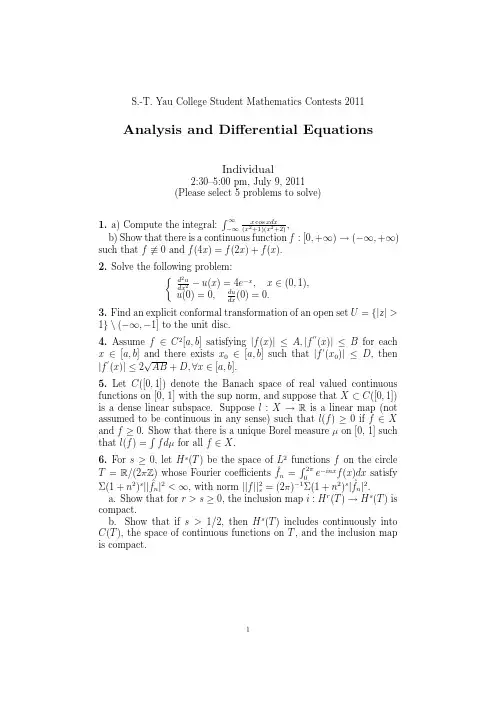
S.-T.Yau College Student Mathematics Contests 2011Analysis and Differential EquationsIndividual2:30–5:00pm,July 9,2011(Please select 5problems to solve)1.a)Compute the integral: ∞−∞x cos xdx (x 2+1)(x 2+2),b)Show that there is a continuous function f :[0,+∞)→(−∞,+∞)such that f ≡0and f (4x )=f (2x )+f (x ).2.Solve the following problem: d 2u dx 2−u (x )=4e −x ,x ∈(0,1),u (0)=0,dudx(0)=0.3.Find an explicit conformal transformation of an open set U ={|z |>1}\(−∞,−1]to the unit disc.4.Assume f ∈C 2[a,b ]satisfying |f (x )|≤A,|f(x )|≤B for each x ∈[a,b ]and there exists x 0∈[a,b ]such that |f (x 0)|≤D ,then |f (x )|≤2√AB +D,∀x ∈[a,b ].5.Let C ([0,1])denote the Banach space of real valued continuous functions on [0,1]with the sup norm,and suppose that X ⊂C ([0,1])is a dense linear subspace.Suppose l :X →R is a linear map (not assumed to be continuous in any sense)such that l (f )≥0if f ∈X and f ≥0.Show that there is a unique Borel measure µon [0,1]such that l (f )= fdµfor all f ∈X .6.For s ≥0,let H s (T )be the space of L 2functions f on the circle T =R /(2πZ )whose Fourier coefficients ˆf n = 2π0e−inx f (x )dx satisfy Σ(1+n 2)s ||ˆf n |2<∞,with norm ||f ||2s =(2π)−1Σ(1+n 2)s |ˆf n |2.a.Show that for r >s ≥0,the inclusion map i :H r (T )→H s (T )is compact.b.Show that if s >1/2,then H s (T )includes continuously into C (T ),the space of continuous functions on T ,and the inclusion map is compact.1S.-T.Yau College Student Mathematics Contests2011Geometry and TopologyIndividual9:30–12:00am,July10,2011(Please select5problems to solve)1.Suppose M is a closed smooth n-manifold.a)Does there always exist a smooth map f:M→S n from M into the n-sphere,such that f is essential(i.e.f is not homotopic to a constant map)?Justify your answer.b)Same question,replacing S n by the n-torus T n.2.Suppose(X,d)is a compact metric space and f:X→X is a map so that d(f(x),f(y))=d(x,y)for all x,y in X.Show that f is an onto map.3.Let C1,C2be two linked circles in R3.Show that C1cannot be homotopic to a point in R3\C2.4.Let M=R2/Z2be the two dimensional torus,L the line3x=7y in R2,and S=π(L)⊂M whereπ:R2→M is the projection map. Find a differential form on M which represents the Poincar´e dual of S.5.A regular curve C in R3is called a Bertrand Curve,if there existsa diffeomorphism f:C→D from C onto a different regular curve D in R3such that N x C=N f(x)D for any x∈C.Here N x C denotes the principal normal line of the curve C passing through x,and T x C will denote the tangent line of C at x.Prove that:a)The distance|x−f(x)|is constant for x∈C;and the angle made between the directions of the two tangent lines T x C and T f(x)D is also constant.b)If the curvature k and torsionτof C are nowhere zero,then there must be constantsλandµsuch thatλk+µτ=16.Let M be the closed surface generated by carrying a small circle with radius r around a closed curve C embedded in R3such that the center moves along C and the circle is in the normal plane to C at each point.Prove thatMH2dσ≥2π2,and the equality holds if and only if C is a circle with radius √2r.HereH is the mean curvature of M and dσis the area element of M.1S.-T.Yau College Student Mathematics Contests 2011Algebra,Number Theory andCombinatoricsIndividual2:30–5:00pm,July 10,2011(Please select 5problems to solve)For the following problems,every example and statement must be backed up by proof.Examples and statements without proof will re-ceive no-credit.1.Let K =Q (√−3),an imaginary quadratic field.(a)Does there exists a finite Galois extension L/Q which containsK such that Gal(L/Q )∼=S 3?(Here S 3is the symmetric group in 3letters.)(b)Does there exists a finite Galois extension L/Q which containsK such that Gal(L/Q )∼=Z /4Z ?(c)Does there exists a finite Galois extension L/Q which containsK such that Gal(L/Q )∼=Q ?Here Q is the quaternion group with 8elements {±1,±i,±j,±k },a finite subgroup of the group of units H ×of the ring H of all Hamiltonian quaternions.2.Let f be a two-dimensional (complex)representation of a finite group G such that 1is an eigenvalue of f (σ)for every σ∈G .Prove that f is a direct sum of two one-dimensional representations of G3.Let F ⊂R be the subset of all real numbers that are roots of monic polynomials f (X )∈Q [X ].(1)Show that F is a field.(2)Show that the only field automorphisms of F are the identityautomorphism α(x )=x for all x ∈F .4.Let V be a finite-dimensional vector space over R and T :V →V be a linear transformation such that(1)the minimal polynomial of T is irreducible;(2)there exists a vector v ∈V such that {T i v |i ≥0}spans V .Show that V contains no non-trivial proper T -invariant subspace.5.Given a commutative diagramA →B →C →D →E↓↓↓↓↓A →B →C →D →E1Algebra,Number Theory and Combinatorics,2011-Individual2 of Abelian groups,such that(i)both rows are exact sequences and(ii) every vertical map,except the middle one,is an isomorphism.Show that the middle map C→C is also an isomorphism.6.Prove that a group of order150is not simple.S.-T.Yau College Student Mathematics Contests 2011Applied Math.,Computational Math.,Probability and StatisticsIndividual6:30–9:00pm,July 9,2011(Please select 5problems to solve)1.Given a weight function ρ(x )>0,let the inner-product correspond-ing to ρ(x )be defined as follows:(f,g ):= baρ(x )f (x )g (x )d x,and let f :=(f,f ).(1)Define a sequence of polynomials as follows:p 0(x )=1,p 1(x )=x −a 1,p n (x )=(x −a n )p n −1(x )−b n p n −2(x ),n =2,3,···wherea n =(xp n −1,p n −1)(p n −1,p n −1),n =1,2,···b n =(xp n −1,p n −2)(p n −2,p n −2),n =2,3,···.Show that {p n (x )}is an orthogonal sequence of monic polyno-mials.(2)Let {q n (x )}be an orthogonal sequence of monic polynomialscorresponding to the ρinner product.(A polynomial is called monic if its leading coefficient is 1.)Show that {q n (x )}is unique and it minimizes q n amongst all monic polynomials of degree n .(3)Hence or otherwise,show that if ρ(x )=1/√1−x 2and [a,b ]=[−1,1],then the corresponding orthogonal sequence is the Cheby-shev polynomials:T n (x )=cos(n arccos x ),n =0,1,2,···.and the following recurrent formula holds:T n +1(x )=2xT n (x )−T n −1(x ),n =1,2,···.(4)Find the best quadratic approximation to f (x )=x 3on [−1,1]using ρ(x )=1/√1−x 2.1Applied Math.Prob.Stat.,2011-Individual 22.If two polynomials p (x )and q (x ),both of fifth degree,satisfyp (i )=q (i )=1i,i =2,3,4,5,6,andp (1)=1,q (1)=2,find p (0)−q (0)y aside m black balls and n red balls in a jug.Supposes 1≤r ≤k ≤n .Each time one draws a ball from the jug at random.1)If each time one draws a ball without return,what is the prob-ability that in the k -th time of drawing one obtains exactly the r -th red ball?2)If each time one draws a ball with return,what is the probability that in the first k times of drawings one obtained totally an odd number of red balls?4.Let X and Y be independent and identically distributed random variables.Show thatE [|X +Y |]≥E [|X |].Hint:Consider separately two cases:E [X +]≥E [X −]and E [X +]<E [X −].5.Suppose that X 1,···,X n are a random sample from the Bernoulli distribution with probability of success p 1and Y 1,···,Y n be an inde-pendent random sample from the Bernoulli distribution with probabil-ity of success p 2.(a)Give a minimum sufficient statistic and the UMVU (uniformlyminimum variance unbiased)estimator for θ=p 1−p 2.(b)Give the Cramer-Rao bound for the variance of the unbiasedestimators for v (p 1)=p 1(1−p 1)or the UMVU estimator for v (p 1).(c)Compute the asymptotic power of the test with critical region |√n (ˆp 1−ˆp 2)/ 2ˆp ˆq |≥z 1−αwhen p 1=p and p 2=p +n −1/2∆,where ˆp =0.5ˆp 1+0.5ˆp 2.6.Suppose that an experiment is conducted to measure a constant θ.Independent unbiased measurements y of θcan be made with either of two instruments,both of which measure with normal errors:fori =1,2,instrument i produces independent errors with a N (0,σ2i )distribution.The two error variances σ21and σ22are known.When ameasurement y is made,a record is kept of the instrument used so that after n measurements the data is (a 1,y 1),...,(a n ,y n ),where a m =i if y m is obtained using instrument i .The choice between instruments is made independently for each observation in such a way thatP (a m =1)=P (a m =2)=0.5,1≤m ≤n.Applied Math.Prob.Stat.,2011-Individual 3Let x denote the entire set of data available to the statistician,in this case (a 1,y 1),...,(a n ,y n ),and let l θ(x )denote the corresponding log likelihood function for θ.Let a =n m =1(2−a m ).(a)Show that the maximum likelihood estimate of θis given by ˆθ= n m =11/σ2a m −1 n m =1y m /σ2a m.(b)Express the expected Fisher information I θand the observedFisher information I x in terms of n ,σ21,σ22,and a .What hap-pens to the quantity I θ/I x as n →∞?(c)Show that a is an ancillary statistic,and that the conditional variance of ˆθgiven a equals 1/I x .Of the two approximations ˆθ·∼N (θ,1/I θ)and ˆθ·∼N (θ,1/I x ),which (if either)would you use for the purposes of inference,and why?S.-T.Yau College Student Mathematics Contests 2011Analysis and Differential EquationsTeam9:00–12:00am,July 9,2011(Please select 5problems to solve)1.Let H 2(∆)be the space of holomorphic functions in the unit disk ∆={|z |<1}such that ∆|f |2|dz |2<∞.Prove that H 2(∆)is a Hilbert space and that for any r <1,the map T :H 2(∆)→H 2(∆)given by T f (z ):=f (rz )is a compact operator.2.For any continuous function f (z )of period 1,show that the equation dϕdt=2πϕ+f (t )has a unique solution of period 1.3.Let h (x )be a C ∞function on the real line R .Find a C ∞function u (x,y )on an open subset of R containing the x -axis such that u x +2u y =u 2and u (x,0)=h (x ).4.Let S ={x ∈R ||x −p |≤c/q 3,for all p,q ∈Z ,q >0,c >0},show that S is uncountable and its measure is zero.5.Let sl (n )denote the set of all n ×n real matrices with trace equal to zero and let SL (n )be the set of all n ×n real matrices with deter-minant equal to one.Let ϕ(z )be a real analytic function defined in a neighborhood of z =0of the complex plane C satisfying the conditions ϕ(0)=1and ϕ (0)=1.(a)If ϕmaps any near zero matrix in sl (n )into SL (n )for some n ≥3,show that ϕ(z )=exp(z ).(b)Is the conclusion of (a)still true in the case n =2?If it is true,prove it.If not,give a counterexample.e mathematical analysis to show that:(a)e and πare irrational numbers;(b)e and πare also transcendental numbers.1S.-T.Yau College Student Mathematics Contests2011Applied Math.,Computational Math.,Probability and StatisticsTeam9:00–12:00am,July9,2011(Please select5problems to solve)1.Let A be an N-by-N symmetric positive definite matrix.The con-jugate gradient method can be described as follows:r0=b−A x0,p0=r0,x0=0FOR n=0,1,...αn= r n 22/(p TnA p n)x n+1=x n+αn p n r n+1=r n−αn A p nβn=−r Tk+1A p k/p TkA p kp n+1=r n+1+βn p nEND FORShow(a)αn minimizes f(x n+αp n)for allα∈R wheref(x)≡12x T A x−b T x.(b)p Ti r n=0for i<n and p TiA p j=0if i=j.(c)Span{p0,p1,...,p n−1}=Span{r0,r1,...,r n−1}≡K n.(d)r n is orthogonal to K n.2.We use the following scheme to solve the PDE u t+u x=0:u n+1 j =au nj−2+bu nj−1+cu njwhere a,b,c are constants which may depend on the CFL numberλ=∆t ∆x .Here x j=j∆x,t n=n∆t and u njis the numerical approximationto the exact solution u(x j,t n),with periodic boundary conditions.(i)Find a,b,c so that the scheme is second order accurate.(ii)Verify that the scheme you derived in Part(i)is exact(i.e.u nj =u(x j,t n))ifλ=1orλ=2.Does this imply that the scheme is stable forλ≤2?If not,findλ0such that the scheme is stable forλ≤λ0. Recall that a scheme is stable if there exist constants M and C,which are independent of the mesh sizes∆x and∆t,such thatu n ≤Me CT u0for all∆x,∆t and n such that t n≤T.You can use either the L∞norm or the L2norm to prove stability.1Applied Math.Prob.Stat.,2011-Team2 3.Let X and Y be independent random variables,identically dis-tributed according to the Normal distribution with mean0and variance 1,N(0,1).(a)Find the joint probability density function of(R,),whereR=(X2+Y2)1/2andθ=arctan(Y/X).(b)Are R andθindependent?Why,or why not?(c)Find a function U of R which has the uniform distribution on(0,1),Unif(0,1).(d)Find a function V ofθwhich is distributed as Unif(0,1).(e)Show how to transform two independent observations U and Vfrom Unif(0,1)into two independent observations X,Y fromN(0,1).4.Let X be a random variable such that E[|X|]<∞.Show thatE[|X−a|]=infE[|X−x|],x∈Rif and only if a is a median of X.5.Let Y1,...,Y n be iid observations from the distribution f(x−θ), whereθis unknown and f()is probability density function symmetric about zero.Suppose a priori thatθhas the improper priorθ∼Lebesgue(flat) on(−∞,∞).Write down the posterior distribution ofθ.Provides some arguments to show that thisflat prior is noninforma-tive.Show that with the posterior distribution in(a),a95%probability interval is also a95%confidence interval.6.Suppose we have two independent random samples{Y1,i=1,...,n} from Poisson with(unknown)meanλ1and{Y i,i=n+1,...,2n}from Poisson with(unknown)meanλ2Letθ=λ1/(λ1+λ2).(a)Find an unbiased estimator ofθ(b)Does your estimator have the minimum variance among all un-biased estimators?If yes,prove it.If not,find one that has theminimum variance(and prove it).(c)Does the unbiased minimum variance estimator you found at-tain the Fisher information bound?If yes,show it.If no,whynot?S.-T.Yau College Student Mathematics Contests2011Geometry and TopologyTeam9:00–12:00am,July9,2011(Please select5problems to solve)1.Suppose K is afinite connected simplicial complex.True or false:a)Ifπ1(K)isfinite,then the universal cover of K is compact.b)If the universal cover of K is compact thenπ1(K)isfinite.pute all homology groups of the the m-skeleton of an n-simplex, 0≤m≤n.3.Let M be an n-dimensional compact oriented Riemannian manifold with boundary and X a smooth vectorfield on M.If n is the inward unit normal vector of the boundary,show thatM div(X)dV M=∂MX·n dV∂M.4.Let F k(M)be the space of all C∞k-forms on a differentiable man-ifold M.Suppose U and V are open subsets of M.a)Explain carefully how the usual exact sequence0−→F(U∪V)−→F(U)⊕F V)−→F(U∩V)−→0 arises.b)Write down the“long exact sequence”in de Rham cohomology as-sociated to the short exact sequence in part(a)and describe explicitly how the mapH kdeR (U∩V)−→H k+1deR(U∪V)arises.5.Let M be a Riemannian n-manifold.Show that the scalar curvature R(p)at p∈M is given byR(p)=1vol(S n−1)S n−1Ric p(x)dS n−1,where Ric p(x)is the Ricci curvature in direction x∈S n−1⊂T p M, vol(S n−1)is the volume of S n−1and dS n−1is the volume element of S n−1.1Geometry and Topology,2011-Team2 6.Prove the Schur’s Lemma:If on a Riemannian manifold of dimension at least three,the Ricci curvature depends only on the base point but not on the tangent direction,then the Ricci curvature must be constant everywhere,i.e.,the manifold is Einstein.S.-T.Yau College Student Mathematics Contests 2011Algebra,Number Theory andCombinatoricsTeam9:00–12:00pm,July 9,2011(Please select 5problems to solve)For the following problems,every example and statement must be backed up by proof.Examples and statements without proof will re-ceive no-credit.1.Let F be a field and ¯Fthe algebraic closure of F .Let f (x,y )and g (x,y )be polynomials in F [x,y ]such that g .c .d .(f,g )=1in F [x,y ].Show that there are only finitely many (a,b )∈¯F×2such that f (a,b )=g (a,b )=0.Can you generalize this to the cases of more than two-variables?2.Let D be a PID,and D n the free module of rank n over D .Then any submodule of D n is a free module of rank m ≤n .3.Identify pairs of integers n =m ∈Z +such that the quotient rings Z [x,y ]/(x 2−y n )∼=Z [x,y ]/(x 2−y m );and identify pairs of integers n =m ∈Z +such that Z [x,y ]/(x 2−y n )∼=Z [x,y ]/(x 2−y m ).4.Is it possible to find an integer n >1such that the sum1+12+13+14+ (1)is an integer?5.Recall that F 7is the finite field with 7elements,and GL 3(F 7)is the group of all invertible 3×3matrices with entries in F 7.(a)Find a 7-Sylow subgroup P 7of GL 3(F 7).(b)Determine the normalizer subgroup N of the 7-Sylow subgroupyou found in (a).(c)Find a 2-Sylow subgroup of GL 3(F 7).6.For a ring R ,let SL 2(R )denote the group of invertible 2×2matrices.Show that SL 2(Z )is generated by T = 1101 and S = 01−10 .What about SL 2(R )?1。
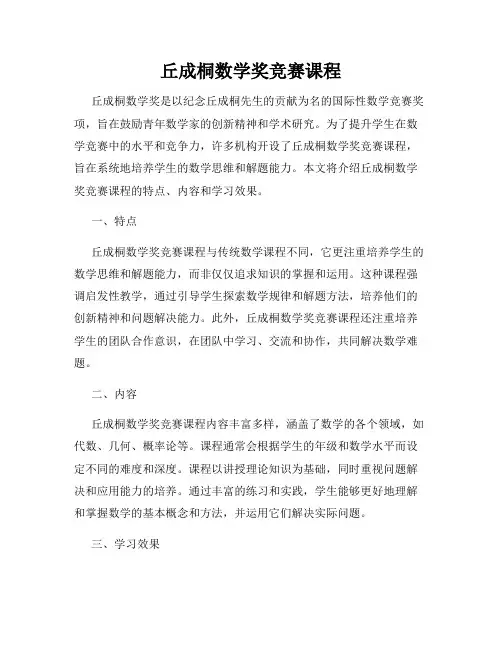
丘成桐数学奖竞赛课程丘成桐数学奖是以纪念丘成桐先生的贡献为名的国际性数学竞赛奖项,旨在鼓励青年数学家的创新精神和学术研究。
为了提升学生在数学竞赛中的水平和竞争力,许多机构开设了丘成桐数学奖竞赛课程,旨在系统地培养学生的数学思维和解题能力。
本文将介绍丘成桐数学奖竞赛课程的特点、内容和学习效果。
一、特点丘成桐数学奖竞赛课程与传统数学课程不同,它更注重培养学生的数学思维和解题能力,而非仅仅追求知识的掌握和运用。
这种课程强调启发性教学,通过引导学生探索数学规律和解题方法,培养他们的创新精神和问题解决能力。
此外,丘成桐数学奖竞赛课程还注重培养学生的团队合作意识,在团队中学习、交流和协作,共同解决数学难题。
二、内容丘成桐数学奖竞赛课程内容丰富多样,涵盖了数学的各个领域,如代数、几何、概率论等。
课程通常会根据学生的年级和数学水平而设定不同的难度和深度。
课程以讲授理论知识为基础,同时重视问题解决和应用能力的培养。
通过丰富的练习和实践,学生能够更好地理解和掌握数学的基本概念和方法,并运用它们解决实际问题。
三、学习效果参加丘成桐数学奖竞赛课程的学生通常会取得显著的学习效果。
首先,课程能够帮助学生建立扎实的数学基础和深厚的数学功底。
其次,通过系统的训练和练习,学生的解题能力和思维灵活性都会有很大提升。
此外,丘成桐数学奖竞赛课程还能够培养学生的自信心和学术热情,激发他们对数学的兴趣和研究的热情。
结语通过参加丘成桐数学奖竞赛课程,学生不仅可以提升数学竞赛的成绩,还能够培养创新思维和解题能力,为未来的学习和职业发展打下坚实的基础。
在这个竞争激烈的时代,具备扎实的数学素养是非常重要的。
因此,我鼓励广大学生积极参加丘成桐数学奖竞赛课程,不断提高自己的数学水平,在未来的人生道路上取得更大的成就。
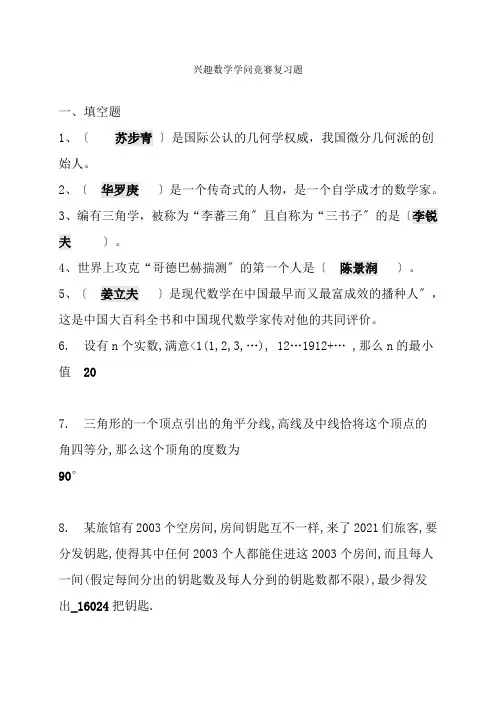
兴趣数学学问竞赛复习题一、填空题1、〔苏步青〕是国际公认的几何学权威,我国微分几何派的创始人。
2、〔华罗庚〕是一个传奇式的人物,是一个自学成才的数学家。
3、编有三角学,被称为“李蕃三角〞且自称为“三书子〞的是〔李锐夫〕。
4、世界上攻克“哥德巴赫揣测〞的第一个人是〔陈景润〕。
5、〔姜立夫〕是现代数学在中国最早而又最富成效的播种人〞,这是中国大百科全书和中国现代数学家传对他的共同评价。
6. 设有n个实数,满意<1(1,2,3,…), 12…1912+… ,那么n的最小值207. 三角形的一个顶点引出的角平分线,高线及中线恰将这个顶点的角四等分,那么这个顶角的度数为90°8. 某旅馆有2003个空房间,房间钥匙互不一样,来了2021们旅客,要分发钥匙,使得其中任何2003个人都能住进这2003个房间,而且每人一间(假定每间分出的钥匙数及每人分到的钥匙数都不限),最少得发出_16024把钥匙.9. 在凸1900边形内取103个点,以这2003个点为顶点,可将原凸1900边形分割成小三角形的个数为2104 .10. 假设实数x满意x4+36<13x2,那么f(x)3-3x的最大值为1811 ."我买鸡蛋时,付给杂货店老板12美分,"一位厨师说道,"但是由于嫌它们太小,我又叫他无偿添加了2只鸡蛋给我。
这样一来,每打(12只)鸡蛋的价钱就比当时的要价降低了1美分。
" 厨师买了_18只鸡蛋12.f(x)∈[0,1],那么(x)+1的取值范围为[7/9,7/8]13. 函数f〔x〕及g〔x〕的定义域均为非负实数集,对随意的x≥0,规定f〔x〕*g〔x〕=min{f〔x〕,g〔x〕}.假设f〔x〕=3-x,g〔x〕=,那么f〔x〕*g〔x〕的最大值为〔2√3-1〕14.∈N,且满意342(1)=379(),设×103×102×10,那么M的值为1949 .15. 用E(n)表示可使5k是乘积112233…的约数为最大的整数k,那么E(150)= 297516. 从1到100的自然数中,每次取出不同的两个数,使它们的和大于100,那么可有_2500种不同的取法.17. 从正整数序列1,2,3,4,…中依次划去3的倍数和4的倍数,但是其中是5的倍数均保存,划完后剩下的数依次构成一个新的序列1=12=23=54=7,…,那么A2003的值为3338.18. .连接凸五边形的每两个顶点总共可得到十条线段(包括边在内),现将其中的几条线段着上着颜色,为了使得该五边形中随意三个顶点所构成的三角形都至少有一条边是有颜色的那么n的最小值是_ 419. x0=20031+ (n>1∈N),那么x2003的整数部分为200321. ≥01,2,…,2003,且a12+…2003=1,那么{a123, a234,…, a2}的最小值为3/2007 _.22. 对于每一对实数,函数f满意f(x)(y)()1,假设f(1)=1,那么使f(n)(n≠1)的整数n共有_1个.23.在棱长为a的正方体内包容9个等球,八个角各放一个,那么这些等球最大半径是. (√3-3/2)a24.都不为0,并且有()()().那么有1 .二、选择题1、被誉为中国现代数学祖师的是〔1、C 〕。
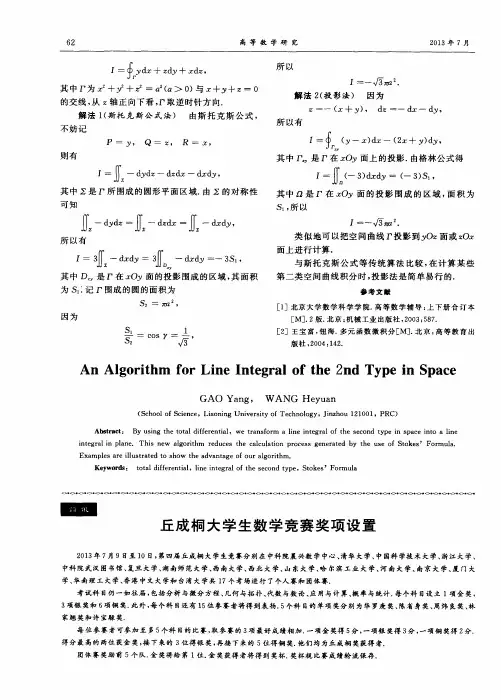
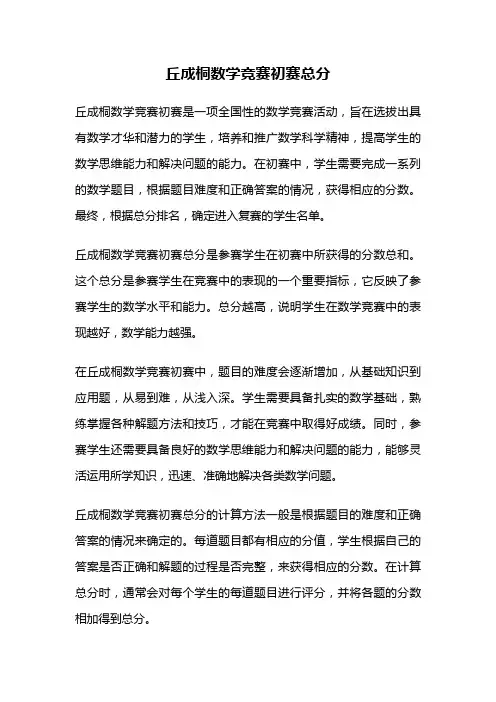
丘成桐数学竞赛初赛总分丘成桐数学竞赛初赛是一项全国性的数学竞赛活动,旨在选拔出具有数学才华和潜力的学生,培养和推广数学科学精神,提高学生的数学思维能力和解决问题的能力。
在初赛中,学生需要完成一系列的数学题目,根据题目难度和正确答案的情况,获得相应的分数。
最终,根据总分排名,确定进入复赛的学生名单。
丘成桐数学竞赛初赛总分是参赛学生在初赛中所获得的分数总和。
这个总分是参赛学生在竞赛中的表现的一个重要指标,它反映了参赛学生的数学水平和能力。
总分越高,说明学生在数学竞赛中的表现越好,数学能力越强。
在丘成桐数学竞赛初赛中,题目的难度会逐渐增加,从基础知识到应用题,从易到难,从浅入深。
学生需要具备扎实的数学基础,熟练掌握各种解题方法和技巧,才能在竞赛中取得好成绩。
同时,参赛学生还需要具备良好的数学思维能力和解决问题的能力,能够灵活运用所学知识,迅速、准确地解决各类数学问题。
丘成桐数学竞赛初赛总分的计算方法一般是根据题目的难度和正确答案的情况来确定的。
每道题目都有相应的分值,学生根据自己的答案是否正确和解题的过程是否完整,来获得相应的分数。
在计算总分时,通常会对每个学生的每道题目进行评分,并将各题的分数相加得到总分。
在竞赛中,参赛学生需要面对各种各样的数学题目,包括代数、几何、数论等不同领域的题目。
这些题目不仅考察了学生的数学知识,还考察了学生的思维能力和解决问题的能力。
参赛学生需要分析问题、抽象问题、推理和证明,才能得出正确的答案。
丘成桐数学竞赛初赛总分的高低对学生来说具有重要意义。
高分不仅可以增加学生进入复赛的机会,还可以为学生争取到更好的名次和奖励。
同时,高分也是学生数学能力的一种证明,可以为学生今后的学习和发展提供有力的支持和证明。
为了取得好的初赛总分,学生需要在平时的学习中注重基础知识的掌握和理解,勤于练习和总结,提高解题的能力和技巧。
此外,学生还可以参加一些数学训练班或辅导班,通过系统的学习和辅导,提高自己的数学水平和竞赛能力。
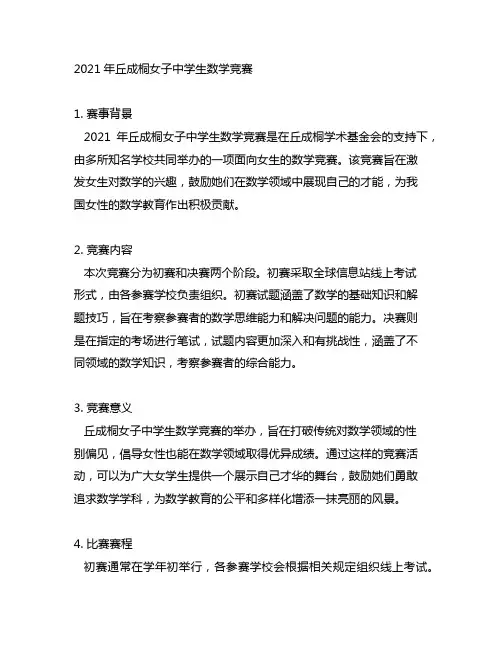
2021年丘成桐女子中学生数学竞赛1. 赛事背景2021年丘成桐女子中学生数学竞赛是在丘成桐学术基金会的支持下,由多所知名学校共同举办的一项面向女生的数学竞赛。
该竞赛旨在激发女生对数学的兴趣,鼓励她们在数学领域中展现自己的才能,为我国女性的数学教育作出积极贡献。
2. 竞赛内容本次竞赛分为初赛和决赛两个阶段。
初赛采取全球信息站线上考试形式,由各参赛学校负责组织。
初赛试题涵盖了数学的基础知识和解题技巧,旨在考察参赛者的数学思维能力和解决问题的能力。
决赛则是在指定的考场进行笔试,试题内容更加深入和有挑战性,涵盖了不同领域的数学知识,考察参赛者的综合能力。
3. 竞赛意义丘成桐女子中学生数学竞赛的举办,旨在打破传统对数学领域的性别偏见,倡导女性也能在数学领域取得优异成绩。
通过这样的竞赛活动,可以为广大女学生提供一个展示自己才华的舞台,鼓励她们勇敢追求数学学科,为数学教育的公平和多样化增添一抹亮丽的风景。
4. 比赛赛程初赛通常在学年初举行,各参赛学校会根据相关规定组织线上考试。
获得初赛资格者,将有机会晋级到决赛阶段。
决赛通常在学年末或次年初举行,在指定的考场进行笔试。
决赛结束后,将公布各项奖项和获奖名单。
5. 奖项设置本次竞赛设立了一、二、三等奖、优秀奖等多个奖项,并对获奖者进行公示和颁奖。
还设立了最佳组织奖、最佳指导奖等特别奖项,以表彰在竞赛过程中表现出色的学校和指导老师。
6. 竞赛影响丘成桐女子中学生数学竞赛以其独特的性别取向和专业水准,受到了广大师生和家长的广泛关注和赞誉。
竞赛不仅帮助参赛学生提高了数学水平和解题能力,也为他们提供了与全国各地学子交流的机会。
通过这样的竞赛活动,还能够鼓励更多女生走进数学领域,为数学教育的多元化和发展注入新的活力和动力。
7. 结语作为面向女生的一项数学竞赛,丘成桐女子中学生数学竞赛旨在为广大女生搭建一个展示自己才华和挑战自我的评台,助力她们在数学领域取得更大的成就。
在未来,希望这样的竞赛能够继续举办,并为更多女学子提供展现自己的机会,为我国数学事业的发展贡献一份力量。
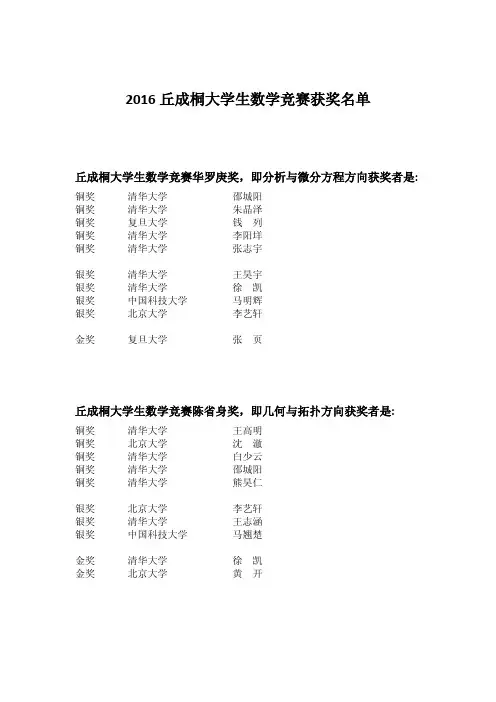
2016丘成桐大学生数学竞赛获奖名单丘成桐大学生数学竞赛华罗庚奖,即分析与微分方程方向获奖者是:铜奖清华大学邵城阳铜奖清华大学朱晶泽铜奖复旦大学钱列铜奖清华大学李阳垟铜奖清华大学张志宇银奖清华大学王昊宇银奖清华大学徐凯银奖中国科技大学马明辉银奖北京大学李艺轩金奖复旦大学张页丘成桐大学生数学竞赛陈省身奖,即几何与拓扑方向获奖者是:铜奖清华大学王高明铜奖北京大学沈澈铜奖清华大学白少云铜奖清华大学邵城阳铜奖清华大学熊昊仁银奖北京大学李艺轩银奖清华大学王志涵银奖中国科技大学马翘楚金奖清华大学徐凯金奖北京大学黄开丘成桐大学生数学竞赛周炜良,即代数、数论与组合方向奖获奖者是:铜奖清华大学王浩旭铜奖中国科技大学钱舰铜奖清华大学张志宇铜奖台湾大学羅啟恒铜奖台湾大学趙庭偉银奖北京大学陈成银奖复旦大学孟凡君银奖台湾大学吴博生金奖北京大学吕世极金奖清华大学徐凯丘成桐大学生数学竞赛林家翘奖,即应用数学与计算数学方向获奖者是:铜奖清华大学刘冠华铜奖北京大学金晨子铜奖清华大学王昊宇银奖武汉大学黄旷银奖北京大学金辉金奖清华大学李阳垟丘成桐大学生数学竞赛许宝騄奖,即概率统计方向获奖者是:铜奖北京大学王飞骋铜奖北京大学付伟龙铜奖北京大学顾超铜奖复旦大学唐博浩银奖北京大学刘浩然金奖清华大学王昊宇丘成桐大学生数学竞赛丘成桐奖,即个人全能奖获奖者是:银奖清华大学张志宇银奖北京大学李艺轩银奖清华大学王昊宇金奖清华大学李阳垟金奖清华大学徐凯丘成桐大学生数学竞赛团体赛获奖者是:铜奖复旦大学钱列、周易铖、石佳、陈小帖、陈品翰铜奖复旦大学孟凡君、邹嘉骅、缪欣晨、金正中、唐博浩铜奖中国科技大学何声、马翘楚、马明辉、高英瓒、袁望钧铜奖北京大学王翔、沈澈、孙成章、金辉、肖非依银奖清华大学徐凯、王志涵、赵瑞屾、贾楸烨、李林骏银奖清华大学王浩旭、白少云、李阳垟、郭怡辰、徐则驰银奖北京大学顾超、黄开、李艺轩、袁宏霖、段雅琦金奖清华大学秦翊宸、王怡、邵城阳、杨羽轩、王昊宇。
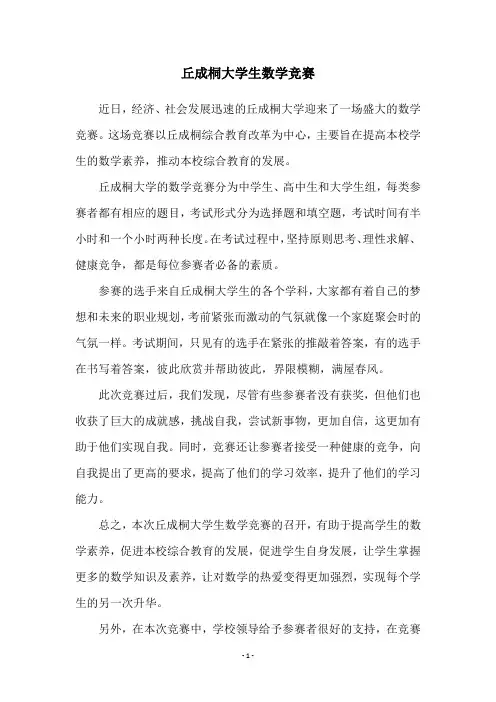
丘成桐大学生数学竞赛
近日,经济、社会发展迅速的丘成桐大学迎来了一场盛大的数学竞赛。
这场竞赛以丘成桐综合教育改革为中心,主要旨在提高本校学生的数学素养,推动本校综合教育的发展。
丘成桐大学的数学竞赛分为中学生、高中生和大学生组,每类参赛者都有相应的题目,考试形式分为选择题和填空题,考试时间有半小时和一个小时两种长度。
在考试过程中,坚持原则思考、理性求解、健康竞争,都是每位参赛者必备的素质。
参赛的选手来自丘成桐大学生的各个学科,大家都有着自己的梦想和未来的职业规划,考前紧张而激动的气氛就像一个家庭聚会时的气氛一样。
考试期间,只见有的选手在紧张的推敲着答案,有的选手在书写着答案,彼此欣赏并帮助彼此,界限模糊,满屋春风。
此次竞赛过后,我们发现,尽管有些参赛者没有获奖,但他们也收获了巨大的成就感,挑战自我,尝试新事物,更加自信,这更加有助于他们实现自我。
同时,竞赛还让参赛者接受一种健康的竞争,向自我提出了更高的要求,提高了他们的学习效率,提升了他们的学习能力。
总之,本次丘成桐大学生数学竞赛的召开,有助于提高学生的数学素养,促进本校综合教育的发展,促进学生自身发展,让学生掌握更多的数学知识及素养,让对数学的热爱变得更加强烈,实现每个学生的另一次升华。
另外,在本次竞赛中,学校领导给予参赛者很好的支持,在竞赛
之前安排培训,并在考试结束后安排讲座,给予参赛者充分利用数学知识,更好地推进自己的发展、腾飞自我的空间。
因此,本次竞赛的重大意义在于:它不仅提高了丘成桐大学生的数学水平,也为本校综合教育的发展做出了重要贡献,再次彰显出我们大学以最热情的方式向社会贡献自己的力量,献出了智慧与力量。
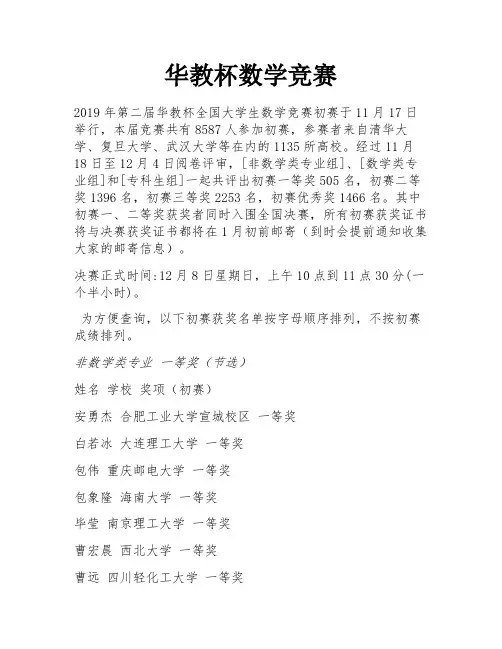
华教杯数学竞赛2019年第二届华教杯全国大学生数学竞赛初赛于11月17日举行,本届竞赛共有8587人参加初赛,参赛者来自清华大学、复旦大学、武汉大学等在内的1135所高校。
经过11月18日至12月4日阅卷评审,[非数学类专业组]、[数学类专业组]和[专科生组]一起共评出初赛一等奖505名,初赛二等奖1396名,初赛三等奖2253名,初赛优秀奖1466名。
其中初赛一、二等奖获奖者同时入围全国决赛,所有初赛获奖证书将与决赛获奖证书都将在1月初前邮寄(到时会提前通知收集大家的邮寄信息)。
决赛正式时间:12月8日星期日,上午10点到11点30分(一个半小时)。
为方便查询,以下初赛获奖名单按字母顺序排列,不按初赛成绩排列。
非数学类专业一等奖(节选)姓名学校奖项(初赛)安勇杰合肥工业大学宣城校区一等奖白若冰大连理工大学一等奖包伟重庆邮电大学一等奖包象隆海南大学一等奖毕莹南京理工大学一等奖曹宏晨西北大学一等奖曹远四川轻化工大学一等奖曹征广东工业大学一等奖查立敏上海建桥学院一等奖查晓薇对外经济贸易大学一等奖常嘉辛保定理工学院一等奖陈柏宇河北工业大学一等奖陈吉通上海交通大学一等奖陈届龙江苏科技大学苏州理工学院一等奖陈露南京理工大学一等奖陈鹏钢重庆邮电大学一等奖陈晓山东大学一等奖陈修言中国石油大学(北京)一等奖陈修羽重庆工商大学一等奖陈一鸣成都理工大学一等奖陈奕岐华南师范大学一等奖陈英剑空军工程大学一等奖陈雨欣中国石油大学(北京)一等奖陈裕飘南昌航空大学一等奖成松涛重庆邮电大学一等奖程万松安徽理工大学一等奖程曦湖南师范大学一等奖程旭欣大连理工大学一等奖程余昊南开大学一等奖仇熠然上海师范大学一等奖褚韩东北电力大学一等奖崔丽颖河北经贸大学一等奖崔怡东北大学一等奖崔兆文贵州大学一等奖黄晨博南京理工大学一等奖黄丹颖江西财经大学一等奖黄佳鑫贵州大学一等奖黄幸四川轻化工大学一等奖黄艺嵚上海海洋大学一等奖贾东杰长春理工大学一等奖姜超大连理工大学一等奖姜福玲大连理工大学一等奖姜凌奇西安交通大学一等奖姜姗姗大连科技学院一等奖姜翟跃南京工程学院一等奖蒋杰豪中山大学一等奖蒋克洋北京理工大学一等奖蒋帅威合肥工业大学宣城校区一等奖金超越大连理工大学盘锦校区一等奖金绍乾湖南农业大学一等奖柯雅静中南大学一等奖孔泽伟东北大学一等奖兰婧浙江大学一等奖雷鹏长沙理工大学一等奖黎羽长江师范学院一等奖李爱西北农林科技大学一等奖李昂曲阜师范大学(日照校区)一等奖李滨贵州大学一等奖李海铭中国政法大学一等奖李佳奇武汉大学一等奖李嘉萱中国石油大学(北京) 一等奖李景文西北农林科技大学一等奖李孟津郑州大学一等奖李侨丽绍兴文理学院一等奖李善斌西南科技大学一等奖李世杰河北工程大学一等奖李爽西南财经大学一等奖李文洁中央财经大学一等奖李文俊南昌大学一等奖李显威中国石油大学(北京) 一等奖李孝涵中国矿业大学一等奖李扬华东交通大学一等奖李晔东郑州大学一等奖李奕典郑州大学一等奖李勇明中国矿业大学一等奖李勇清南昌大学一等奖李泽铖广东工业大学一等奖李泽远同济大学一等奖李知旂中国石油大学(北京)一等奖李周婧东北财经大学一等奖李壮中国石油大学(北京)一等奖李子逸天津工业大学一等奖历英涵大连理工大学一等奖梁大永对外经济贸易大学一等奖梁家宾重庆大学一等奖梁靖婧中山大学珠海校区一等奖梁明滔广东工业大学一等奖梁同南昌航空大学一等奖梁潇中南财经政法大学一等奖廖唯迦成都信息工程大学一等奖廖宇松长安大学一等奖林聪临沂大学一等奖林君逸中山大学一等奖林霞东北财经大学一等奖蔺康中国矿业大学一等奖刘才宏太原理工大学一等奖刘畅湖北大学一等奖刘畅大连理工大学一等奖刘成龙湖南大学一等奖刘凤浩四川大学锦江学院一等奖刘冠宇南京大学一等奖刘海洋合肥工业大学宣城校区一等奖刘翰峰东北农业大学一等奖刘恒峰武汉科技大学一等奖刘家铭江西财经大学一等奖刘靖渲西安电子科技大学一等奖刘俊城江西财经大学一等奖刘凯文南通大学一等奖刘亮北京理工大学一等奖刘墨燃大连理工大学一等奖刘沛天大连理工大学一等奖刘倩霓上海建桥学院一等奖刘群中国矿业大学一等奖刘小也武汉大学一等奖刘心怡北京理工大学一等奖刘新宇南京师范大学一等奖刘旭东西北农林科技大学一等奖刘炫君北京理工大学珠海学院一等奖刘洋东北石油大学一等奖刘一霖中国石油大学(北京)一等奖刘逸宁东北大学一等奖刘颖青岛大学一等奖刘永吉沈阳航空航天大学一等奖刘宇山东大学一等奖刘雨婷重庆工商大学一等奖刘禹轩大连理工大学一等奖娄庆楠山东科技大学一等奖卢萍萍南京师范大学一等奖卢琦江西财经大学一等奖卢哲华南师范大学一等奖陆杰西安交通大学一等奖陆雨楠南京农业大学一等奖吕金泽中国矿业大学一等奖吕乐旖南京理工大学一等奖。
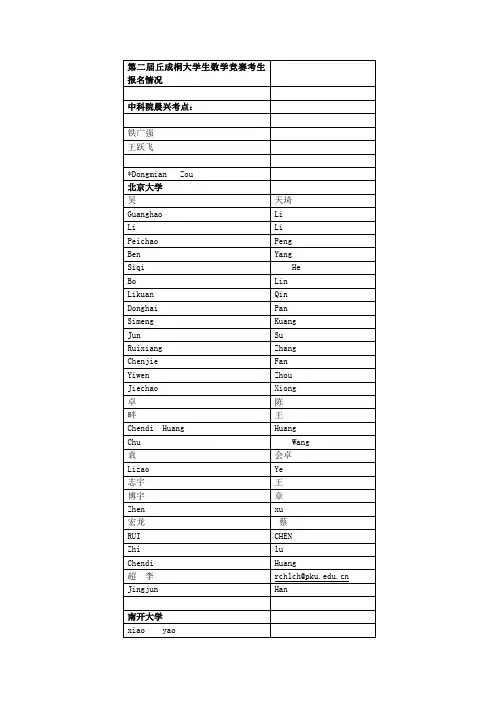
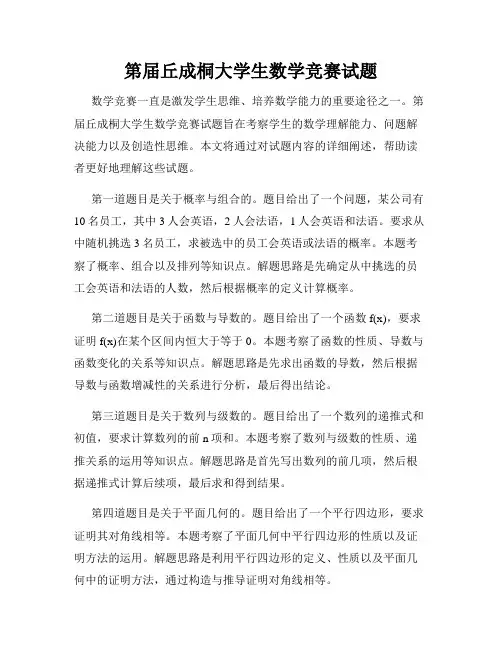
第届丘成桐大学生数学竞赛试题数学竞赛一直是激发学生思维、培养数学能力的重要途径之一。
第届丘成桐大学生数学竞赛试题旨在考察学生的数学理解能力、问题解决能力以及创造性思维。
本文将通过对试题内容的详细阐述,帮助读者更好地理解这些试题。
第一道题目是关于概率与组合的。
题目给出了一个问题,某公司有10名员工,其中3人会英语,2人会法语,1人会英语和法语。
要求从中随机挑选3名员工,求被选中的员工会英语或法语的概率。
本题考察了概率、组合以及排列等知识点。
解题思路是先确定从中挑选的员工会英语和法语的人数,然后根据概率的定义计算概率。
第二道题目是关于函数与导数的。
题目给出了一个函数f(x),要求证明f(x)在某个区间内恒大于等于0。
本题考察了函数的性质、导数与函数变化的关系等知识点。
解题思路是先求出函数的导数,然后根据导数与函数增减性的关系进行分析,最后得出结论。
第三道题目是关于数列与级数的。
题目给出了一个数列的递推式和初值,要求计算数列的前n项和。
本题考察了数列与级数的性质、递推关系的运用等知识点。
解题思路是首先写出数列的前几项,然后根据递推式计算后续项,最后求和得到结果。
第四道题目是关于平面几何的。
题目给出了一个平行四边形,要求证明其对角线相等。
本题考察了平面几何中平行四边形的性质以及证明方法的运用。
解题思路是利用平行四边形的定义、性质以及平面几何中的证明方法,通过构造与推导证明对角线相等。
第五道题目是关于立体几何的。
题目给出了一个正方体,要求计算其对角线的长度。
本题考察了立体几何中正方体的性质以及计算几何的方法。
解题思路是利用正方体的定义、性质以及勾股定理,通过计算两个相邻顶点的距离得到对角线的长度。
第六道题目是关于数论的。
题目给出了一个整数方程,要求求解整数解。
本题考察了数论中整数方程求解的方法。
解题思路是根据方程的特点进行分析,通过整数的性质和运算规律,找出满足方程的整数解。
通过对试题的详细阐述,相信读者对第届丘成桐大学生数学竞赛试题有了更好的理解。
Computational Mathematics,Applied Mathematics,Probability and Statistics(the second draft)Computational MathematicsInterpolation and approximationPolynomial interpolation and least square approximation;trigonometric interpolation and approximation,fast Fourier transform;approximations by rational functions;splines.Nonlinear equation solversConvergence of iterative methods(bisection,secant method,Newton method, other iterative methods)for both scalar equations and systems;finding roots of polynomials.Linear systems and eigenvalue problemsDirect solvers(Gauss elimination,LU decomposition,pivoting,operation count,banded matrices,round-off error accumulation);iterative solvers (Jacobi,Gauss-Seidel,successive over-relaxation,conjugate gradient method, multi-grid method,Krylov methods);numerical solutions for eigenvalues and eigenvectorsNumerical solutions of ordinary differential equationsOne step methods(Taylor series method and Runge-Kutta method);stability, accuracy and convergence;absolute stability,long time behavior;multi-step methodsNumerical solutions of partial differential equationsFinite difference method;stability,accuracy and convergence,Lax equivalence theorem;finite element method,boundary value problems References:[1] C.de Boor and S.D.Conte,Elementary Numerical Analysis,an algorithmic approach,McGraw-Hill,2000.[2]G.H.Golub and C.F.van Loan,Matrix Computations,third edition,Johns Hopkins University Press,1996.[3] E.Hairer,P.Syvert and G.Wanner,Solving Ordinary Differential Equations,Springer,1993.[4] B.Gustafsson,H.-O.Kreiss and J.Oliger,Time Dependent Problems and Difference Methods,John Wiley Sons,1995.[5]G.Strang and G.Fix,An Analysis of the Finite Element Method,second edition,Wellesley-Cambridge Press,2008.Applied MathematicsODE with constant coefficients;Nonlinear ODE:critical points,phase space&stability analysis; Hamiltonian,gradient,conservative ODE’s.Calculus of Variations:Euler-Lagrange Equations;Boundary Conditions,parametric formulation; optimal control and Hamiltonian,Pontryagin maximum principle.First order partial differential equations(PDE)and method of characteristics;Heat,wave,and Laplace’s equation;Separation of variables and eigen-function expansions;Stationary phase method;Homogenization method for elliptic and linear hyperbolic PDEs;Homogenization and front propagation of Hamilton-Jacobi equations;Geometric optics for dispersive wave equations.References:W.D.Boyce and R.C.DiPrima,Elementary Differential Equations,Wiley,2009F.Y.M.Wan,Introduction to Calculus of Variations and Its Applications,Chapman&Hall,1995G.Whitham,“Linear and Nonlinear Waves”,John-Wiley and Sons,1974.J.Keener,“Principles of Applied Mathematics”,Addison-Wesley,1988.A.Benssousan,P-L Lions,G.Papanicolaou,“Asymptotic Analysis for Periodic Structures”,North-Holland Publishing Co,1978.V.Jikov,S.Kozlov,O.Oleinik,“Homogenization of differential operators and integral functions”, Springer,1994.J.Xin,“An Introduction to Fronts in Random Media”,Surveys and Tutorials in Applied Math Sciences,No.5,Springer,2009.ProbabilityRandom Variables;Conditional Probability and Conditional Expectation;Markov Chains;The Exponential Distribution and the Poisson Process;Continuous-Time Markov Chains;Renewal Theory and Its Applications;Queueing Theory;Reliability Theory;Brownian Motion and Stationary Processes;Simulation.Reference:Sheldon M.Ross,Introduction to Probability ModelsStatisticsDistribution Theory and Basic StatisticsFamilies of continuous distributions:Chi-sq,t,F,gamma,beta;Families of discrete distributions: Multinomial,Poisson,negative binomial;Basic statistics:Mean,median,quantiles,order statisticsLikelihood principleLikelihood function,parametric inference,sufficiency,factorization theorem,ancillary statistic, conditional likelihood,marginal likelihood.TestingNeyman-Pearson paradigm,null and alternative hypotheses,simple and composite hypotheses, type I and type II errors,power,most powerful test,likelihood ratio test,Neyman-Pearson Theorem,monotone likelihood ratio,uniformly most powerful test,generalized likelihood ratio test.EstimationParameter estimation,method of moments,maximum likelihood estimation,unbiasedness, quadratic and other criterion functions,Rao-Blackwell Theorem,Fisher information,Cramer-Rao bound,confidence interval,duality between confidence interval and hypothesis testing.Bayesian StatisticsPrior,posterior,conjugate priors,Bayesian lossNonparametric statisticsPermutation test,permutation distribution,rank statistics,Wilcoxon-Mann-Whitney test,log-rank test,Kolmogorov-Smirnov-type tests.RegressionLinear regression,least squares method,Gauss-Markov Theorem,logistic regression,maximum likelihoodLarge sample theoryConsistency,asymptotic normality,chi-sq approximation to likelihood ratio statistic,large-sample based confidence interval,asymptotic properties of empirical distribution.ReferencesCasella,G.and Berger,R.L.(2002).Statistical Inference(2nd Ed.)Duxbury Press.茆诗松,程依明,濮晓龙,概率论与数理统计教程(第二版),高等教育出版社,2008.陈家鼎,孙山泽,李东风,刘力平,数理统计学讲义,高等教育出版社,2006.郑明,陈子毅,汪嘉冈,数理统计讲义,复旦大学出版社,2006.陈希孺,倪国熙,数理统计学教程,中国科学技术大学出版社,2009.。
S.-T.Yau College Student Mathematics Contests 2010Analysis and Differential EquationsTeam(Please select 5problems to solve)1.a)Let f (z )be holomorphic in D :|z |<1and |f (z )|≤1(z ∈D ).Prove that|f (0)|−|z |1+|f (0)||z |≤|f (z )|≤|f (0)|+|z |1−|f (0)||z |.(z ∈D )b)For any finite complex value a ,prove that 12π 2π0log |a −e iθ|dθ=max {log |a |,0}.2.Let f ∈C 1(R ),f (x +1)=f (x ),for all x ,then we have ||f ||∞≤ 10|f (t )|dt + 10|f (t )|dt.3.Consider the equation¨x +(1+f (t ))x =0.We assume that ∞|f (t )|dt <∞.Study the Lyapunov stability of the solution (x,˙x )=(0,0).4.Suppose f :[a,b ]→R be a L 1-integrable function.Extend f to be 0outside the interval [a,b ].Letφ(x )=12h x +h x −hf Show thatb a |φ|≤ b a |f |.5.Suppose f ∈L 1[0,2π],ˆf (n )=12π 2π0f (x )e −inx dx ,prove that 1)∞ |n |=0|ˆf(n )|2<∞implies f ∈L 2[0,2π],2)n |n ˆf (n )|<∞implies that f =f 0,a.e.,f 0∈C 1[0,2π],where C 1[0,2π]is the space of functions f over [0,1]such that both f and its derivative f are continuous functions.126.SupposeΩ⊂R3to be a simply connected domain andΩ1⊂Ωwith boundaryΓ.Let u be a harmonic function inΩand M0=(x0,y0,z0)∈Ω1.Calculate the integral:II=−Γu∂∂n(1r)−1r∂u∂ndS,where 1r=1(x−x0)2+(y−x0)2+(z−x0)2and∂∂ndenotes theout normal derivative with respect to boundaryΓof the domainΩ1.(Hint:use the formula∂v∂n dS=∂v∂xdy∧dz+∂v∂ydz∧dx+∂v∂zdx∧dy.)S.-T.Yau College Student Mathematics Contests 2010Applied Math.,Computational Math.,Probability and StatisticsTeam(Please select 5problems to solve)1.Let X 1,···,X n be independent and identically distributed random variables with continuous distribution functions F (x 1),···,F (x n ),re-spectively.Let Y 1<···<Y n be the order statistics of X 1,···,X n .Prove that Z j =F (Y j )has the beta (j,n −j +1)distribution (j =1,···,n ).2.Let X 1,···,X n be i.i.d.random variable with a continuous density f at point 0.LetY n,i =34b n (1−X 2i /b 2n )I (|X i |≤b n ).Show that n i =1(Y n,i −EY n,i )(b n n i =1Y n,i )1/2L −→N (0,3/5),provided b n →0and nb n →∞.3.Let X 1,···,X n be independently and indentically distributed ran-dom variables with X i ∼N (θ,1).Suppose that it is known that |θ|≤τ,where τis given.Showmin a 1,···,a n +1sup |θ|≤τE (n i =1a i X i +a n +1−θ)2=τ2n −1τ2+n −1.Hint:Carefully use the sufficiency principle.4.The rules for “1and 1”foul shooting in basketball are as follows.The shooter gets to try to make a basket from the foul line.If he succeeds,he gets another try.More precisely,he make 0baskets by missing the first time,1basket by making the first shot and xsmissing the second one,or 2baskets by making both shots.Let n be a fixed integer,and suppose a player gets n tries at “1and 1”shooting.Let N 0,N 1,and N 2be the random variables recording the number of times he makes 0,1,or 2baskets,respectively.Note that N 0+N 1+N 2=n .Suppose that shots are independent Bernoulli trails with probability p for making a basket.(a)Write down the likelihood for (N 0,N 1,N 2).12(b)Show that the maximum likelihood estimator of p is ˆp =N 1+2N 2N 0+2N 1+2N 2.(c)Is ˆp an unbiased estimator for p ?Prove or disprove.(Hint:E ˆp is a polynomial in p ,whose order is higher than 1for p ∈(0,1).)(d)Find the asymptotic distribution of ˆp as n tends to ∞.5.When considering finite difference schemes approximating partial differential equations (PDEs),for example,the scheme(1)u n +1j =u n j −λ(u n j −u n j −1)where λ=∆t ∆x ,approximating the PDE (2)u t +u x =0,we are often interested in stability,namely(3)||u n ||≤C ||u 0||,n ∆t ≤T for a constant C =C (T )independent of the time step ∆t and the spa-tial mesh size ∆x .Here ||·||is a given norm,for example the L 2norm orthe L ∞norm,of the numerical solution vector u n =(u n 1,u n 2,···,u n N ).The mesh points are x j =j ∆x ,t n =n ∆t ,and the numerical solutionu n j approximates the exact solution u (x j ,t n )of the PDE (2)with aperiodic boundary condition.(i)Prove that the scheme (1)is stable in the sense of (3)for boththe L 2norm and the L ∞norm under the time step restriction λ≤1.(ii)Since the numerical solution u n is in a finite dimensional space,Student A argues that the stability (3),once proved for a spe-cific norm ||·||a ,would also automatically hold for any other norm ||·||b .His argument is based on the equivalency of all norms in a finite dimensional space,namely for any two norms ||·||a and ||·||b on a finite dimensional space W ,there exists a constant δ>0such thatδ||u ||b ≤||u ||a ≤1δ||u ||b .Do you agree with his argument?If yes,please give a detailed proof of the following theorem:If a scheme is stable,namely (3)holds for one particular norm (e.g.the L 2norm),then it is also stable for any other norm.If not,please explain the mistake made by Student A.6.We have the following 3PDEs(4)u t +Au x =0,(5)u t +Bu x =0,3 (6)u t+Cu x=0,C=A+B.Here u is a vector of size m and A and B are m×m real matrices. We assume m≥2and both A and B are diagonalizable with only real eigenvalues.We also assume periodic initial condition for these PDEs.(i)Prove that(4)and(5)are both well-posed in the L2-norm.Recall that a PDE is well-posed if its solution satisfies||u(·,t)||≤C(T)||u(·,0)||,0≤t≤Tfor a constant C(T)which depends only on T.(ii)Is(6)guaranteed to be well-posed as well?If yes,give a proof;if not,give a counter example.(iii)Suppose we have afinite difference schemeu n+1=A h u nfor approximating(4)and another schemeu n+1=B h u nfor approximating(5).Suppose both schemes are stable in theL2-norm,namely(3)holds for both schemes.If we now formthe splitting schemeu n+1=B h A h u nwhich is a consistent scheme for solving(6),is this scheme guar-anteed to be L2stable as well?If yes,give a proof;if not,givea counter example.S.-T.Yau College Student Mathematics Contests2010Geometry and TopologyTeam(Please select5problems to solve)1.Let S n⊂R n+1be the unit sphere,and R n⊂R n+1the equator n-plane through the center of S n.Let N be the north pole of S n.Define a mappingπ:S n\{N}→R n called the stereographic projection that takes A∈S n\{N}into the intersection A ∈R n of the equator n-plane R n with the line which passes through A and N.Prove that the stereographic projection is a conformal change,and derive the standard metric of S n by the stereographic projection.2.Let M be a(connected)Riemannian manifold of dimension2.Let f be a smooth non-constant function on M such that f is bounded from above and∆f≥0everywhere on M.Show that there does not exist any point p∈M such that f(p)=sup{f(x):x∈M}.3.Let M be a compact smooth manifold of dimension d.Prove that there exists some n∈Z+such that M can be regularly embedded in the Euclidean space R n.4.Show that any C∞function f on a compact smooth manifold M (without boundary)must have at least two critical points.When M is the2-torus,show that f must have more than two critical points.5.Construct a space X with H0(X)=Z,H1(X)=Z2×Z3,H2(X)= Z,and all other homology groups of X vanishing.6.(a).Define the degree deg f of a C∞map f:S2−→S2and prove that deg f as you present it is well-defined and independent of any choices you need to make in your definition.(b).Prove in detail that for each integer k(possibly negative),there is a C∞map f:S2−→S2of degree k.1S.-T.Yau College Student Mathematics Contests 2010Algebra,Number Theory andCombinatoricsTeam(Please select 5problems to solve)1.For a real number r ,let [r ]denote the maximal integer less or equal than r .Let a and b be two positive irrational numbers such that 1a +1b = 1.Show that the two sequences of integers [ax ],[bx ]for x =1,2,3,···contain all natural numbers without repetition.2.Let n ≥2be an integer and consider the Fermat equationX n +Y n =Z n ,X,Y,Z ∈C [t ].Find all nontrivial solution (X,Y,Z )of the above equation in the sense that X,Y,Z have no common zero and are not all constant.3.Let p ≥7be an odd prime number.(a)Evaluate the rational number cos(π/7)·cos(2π/7)·cos(3π/7).(b)Show that (p −1)/2n =1cos(nπ/p )is a rational number and deter-mine its value.4.For a positive integer a ,consider the polynomialf a =x 6+3ax 4+3x 3+3ax 2+1.Show that it is irreducible.Let F be the splitting field of f a .Show that its Galois group is solvable.5.Prove that a group of order 150is not simple.6.Let V ∼=C 2be the standard representation of SL 2(C ).(a)Show that the n -th symmetric power V n =Sym n V is irre-ducible.(b)Which V n appear in the decomposition of the tensor productV 2⊗V 3into irreducible representations?1。
丘成桐大学生数学竞赛参考书Geometry and Topology (the second draft)Space curves and surfacesCurves and Parametrization, Regular Surfaces; Inverse Images of Regular Values.Gauss Map and Fundamental Properties; Isometries; Conformal Maps; Rigidity of the Sphere.Topological spaceSpace, maps, compactness and connectedness, quotients; Paths and Homotopy. The Fundamental Group of the Circle. Induced Homomorphisms. Free Products of Groups. The van Kampen Theorem. Covering Spaces and Lifting Properties; Simplex and complexes. Triangulations. Surfaces and its classification.Differential ManifoldsDifferentiable Manifolds and Submanifolds, Differentiable Functions and Mappings; The Tangent Space, Vector Field and Covector Fields. Tensors and Tensor Fields and differential forms. The Riemannian Metrics as examples, Orientation and Volume Element; Exterior Differentiation and Frobenius's Theorem; Integration on manifolds, Manifolds with Boundary and Stokes' Theorem.Homology and cohomologySimplicial and Singular Homology. Homotopy Invariance. Exact Sequences and Excision. Degree. Cellular Homology. Mayer-Vietoris Sequences. Homology with Coefficients. The Universal Coefficient Theorem. Cohomology of Spaces. The Cohomology Ring. A Kunneth Formula. Spaces with Polynomial Cohomology. Orientations and Homology. Cup Product and Duality.Riemannian ManifoldsDifferentiation and connection, Constant Vector Fields and Parallel DisplacementRiemann Curvatures and the Equations of Structure Manifolds of Constant Curvature,Spaces of Positive Curvature, Spaces of Zero Curvature, Spaces of Constant Negative CurvatureReferences:M. do Carmo , Differentia geometry of curves and surfaces.Prentice- Hall, 1976 (25th printing)Chen Qing and Chia Kuai Peng, Differential GeometryM. Armstrong, Basic Topology Undergraduate texts in mathematicsW.M. Boothby, An Introduction to Differentiable Manifolds and Riemannian Geometry Academic Press, Inc., Orlando, FL, 1986M. Spivak, A comprehensive introduction to differential geometryN. Hicks, Notes on differential geometry, Van Nostrand.T. Frenkel, Geometry of PhysicsJ. Milnor, Morse TheoryA Hatcher, Algebraic Topology(/~hatcher/AT/ATpage.html)J. Milnor, Topology from the differentiable viewpointR. Bott and L. Tu, Differential forms in algebraic topologyV. Guillemin, A. Pollack, Differential topologyAlgebra, Number Theory and Combinatorics (second draft)Linear AlgebraAbstract vector spaces; subspaces; dimension; matrices and linear transformations; matrix algebras and groups; determinants and traces; eigenvectors and eigenvalues, characteristic and minimal polynomials; diagonalization and triangularization of operators; invariant subspaces and canonical forms; inner products and orthogonalbases; reduction of quadratic forms; hermitian and unitary operators, bilinear forms; dual spaces; adjoints. tensor products and tensor algebras;Integers and polynomialsIntegers, Euclidean algorithm, unique decomposition; congruence and the Chinese Remainder theorem; Quadratic reciprocity ; Indeterminate Equations. Polynomials, Euclidean algorithm, uniqueness decomposition, zeros; The fundamental theorem of algebra; Polynomials of integer coefficients, the Gauss lemma and the Eisenstein criterion; Polynomials of several variables, homogenous and symmetric polynomials, the fundamental theorem of symmetric polynomials.GroupGroups and homomorphisms, Sylow theorem, finitely generated abelian groups. Examples: permutation groups, cyclic groups, dihedral groups, matrix groups, simple groups, Jordan-Holder theorem, linear groups (GL(n, F) and its subgroups), p-groups, solvable and nilpotent groups, group extensions, semi-direct products, free groups, amalgamated products and group presentations.RingBasic properties of rings, units, ideals, homomorphisms, quotient rings, prime and maximal ideals, fields of fractions, Euclidean domains, principal ideal domains and unique factorization domains, polynomial and power series rings, Chinese Remainder Theorem, local rings and localization, Nakayama's lemma, chain conditions and Noetherian rings, Hilbert basis theorem, Artin rings, integral ring extensions, Nullstellensatz, Dedekind domains,algebraic sets, Spec(A).ModuleModules and algebra Free and projective; tensor products; irreducible modules and Schur’s lemma; semisimple, simple and primitive rings; density and Wederburn theorems; the structure of finitely generated modules over principal ideal domains, with application to abelian groups and canonical forms; categories and functors; complexes, injective modues, cohomology; Tor and Ext.FieldField extensions, algebraic extensions, transcendence bases; cyclic and cyclotomic extensions; solvability of polynomial equations; finite fields; separable and inseparable extensions; Galois theory, norms and traces, cyclic extensions, Galois theory of number fields, transcendence degree, function fields.Group representationIrreducible representations, Schur's lemma, characters, Schur orthogonality, character tables, semisimple group rings, induced representations, Frobenius reciprocity, tensor products, symmetric and exterior powers, complex, real, and rational representations.Lie AlgebraBasic concepts, semisimple Lie algebras, root systems, isomorphism and conjugacy theorems, representation theory.Combinatorics (TBA)References:Strang, Linear algebra, Academic Press.I.M. Gelfand, Linear Algebra《整数与多项式》冯克勤余红兵著高等教育出版社Jacobson, Nathan Basic algebra. I. Second edition. W. H. Freeman and Company, New York, 1985. xviii+499 pp.。
2016丘成桐大学生数学竞赛优胜奖名单分析与微分方程清华大学陈钇帆清华大学董从翰北京大学董子超清华大学干盛文武汉大学郝子墨复旦大学何东辰清华大学贾瑨清华大学贾楸烨台灣大學江泓复旦大学金羽佳清华大学李林骏台灣大學李自然清华大学刘冠华中国科技大学马翘楚中国科技大学马骁山东大学乔一坤复旦大学石佳清华大学涂绪山北京大学王飞骋清华大学王可预浙江大学王慎融北京大学王翔清华大学王怡清华大学熊昊仁清华大学张翔宇北京大学赵洛晨清华大学赵瑞屾复旦大学周易铖清华大学朱永兴复旦大学邹嘉骅几何与拓扑复旦大学査承晗上海交通大学刁亦杰清华大学董从翰中国科技大学何声中国科技大学胡曦煜清华大学贾楸烨台灣大學江泓台灣大學李龍欣清华大学刘冠华清华大学罗鑫涛中国科技大学马骁复旦大学孟筱枫南京大学阮宇平北京大学孙成章北京大学王翔中国科技大学王轶堃山东大学吴保君复旦大学吴海涵南开大学颜俊榕四川大学姚琪厦门大学张良肇清华大学赵瑞屾复旦大学周易铖清华大学朱晶泽复旦大学邹嘉骅代数、数论与组合北京大学韩松奇中国科技大学何厚睿南京大学胡龙玺台灣大學江泓台灣大學李自然清华大学刘冠华中国科技大学毛天乐山东大学毛通复旦大学牛文君清华大学齐仁睿复旦大学钱列清华大学秦翊宸北京大学沈澈湖南大学沈子轩北京大学孙成章中国科技大学孙泽铭中国科技大学汪亦桐北京大学王翔华中师范大学吴晓旭清华大学吴志翔中国科技大学鲜文瀚上海交通大学张驰麟北京大学赵梓文兰州大学周胜铉应用数学与计算数学北京大学陈成中国科技大学陈皓清华大学陈钇帆中国科技大学高英瓒清华大学郭怡辰北京大学韩松奇清华大学贾楸烨台灣大學江泓复旦大学金正中北京大学李大为北京大学李冠淳武汉大学李轩复旦大学任骋力复旦大学任奕复旦大学石佳清华大学王柏然中国科技大学王子丰台灣大學吴博生北京大学辛未清华大学熊昊仁北京大学徐芦泽清华大学杨羽轩北京大学袁宏霖台灣大學趙庭偉清华大学朱晶泽概率统计复旦大学陈品翰中国政法大学储备哈尔滨工业大学(威海)黄元开北京大学金晨子北京大学李兴远北京大学刘驰洲中国科技大学马明辉中国科技大学马翘楚南开大学任少康北京大学孙成章南京大学王瑾旸中南大学王鲸中国科技大学王炜复旦大学吴佩学北京大学肖非依北京大学辛未中国地质大学(武汉)熊东北京大学严煜凌武汉大学喻洋中国科技大学袁望钧北京大学张浩然中国科技大学张羽丰北京大学赵洛晨北京大学郑亦如中国科技大学朱秋雨。
丘成桐大学数学竞赛试题及解答一、选择题1. 某数列的前5项为1, 4, 7, 10, 13,求第100项的值。
解答:根据题意可知,该数列的公差为3,第100项的值可以由以下公式得出:a_n = a_1 + (n-1)d其中,a_n 表示第n项的值,a_1 表示首项的值,d 表示公差。
代入已知条件,即可求出第100项的值:a_100 = 1 + (100-1)3= 1 + 99*3= 298所以,第100项的值为298。
2. 设函数 f(x) = x^2 + 2x + 1,求 f(3) 的值。
解答:将 x = 3 代入函数 f(x) 中,即可求得 f(3) 的值:f(3) = 3^2 + 2*3 + 1= 9 + 6 + 1= 16所以,f(3) 的值为16。
二、填空题1. 已知 a + b = 5,且 a - b = 3,求 a 和 b 的值。
解答:将两个等式相加得到:(a + b) + (a - b) = 5 + 32a = 8a = 4将 a 的值代入第一个等式可求得 b 的值:4 + b = 5b = 1所以,a 的值为4,b 的值为1。
2. 若 a:b = 2:3,且 a + b = 25,求 a 和 b 的值。
解答:设 a 的倍数为 2x,b 的倍数为 3x,则有:2x + 3x = 255x = 25x = 5将 x 的值代入 a:b 的比例中,可求得 a 和 b 的值:a = 2 * 5 = 10b = 3 * 5 = 15所以,a 的值为10,b 的值为15。
三、解答题1. 求解下列方程组:2x + y = 53x + 2y = 8解答:可以通过消元法解决这个方程组。
首先将第一个方程乘以2,得到:4x + 2y = 10然后将第二个方程减去第一个方程,消去 y 的系数:4x + 2y - (3x + 2y) = 10 - 84x + 2y - 3x - 2y = 2x = 2将 x 的值代入第一个方程,可求得 y 的值:2*2 + y = 54 + y = 5y = 1所以,该方程组的解为 x = 2,y = 1。
关于举办第二届丘成桐大学生数学竞赛的通知经丘成桐大学生数学竞赛组委会研究决定,第二届丘成桐大学生数学竞赛笔试将于2011年7月9日至10日举行。
届时竞赛组委会将组织专家集中阅卷,评选出参加决赛(面试)的团队和个人名单。
第二届丘成桐大学生数学竞赛决赛将于2011年8月19日至20日在北京举行。
竞赛组委会现已开通了第二届丘成桐大学生数学竞赛网上报名系统:/registration/register.php报名截止日期为2011年6月20日。
参加过首届丘成桐大学生数学竞赛的在读大学生仍可报名参加第二届丘成桐大学生数学竞赛。
欢迎中国(包括大陆、香港、澳门和台湾)高校在读大学生踊跃报名参加第二届丘成桐大学生数学竞赛。
丘成桐大学生数学竞赛组委会2011年3月11日当代著名数学家丘成桐教授最近提议,在中国(包括中国大陆、香港和台湾)的高校开展大学生数学竞赛,以全面测试大学生的数学知识、修养与能力,促进中国的大学数学教育改革。
丘先生领衔的学术与命题委员会将基础数学与应用数学凝练成分析与微分方程,几何与拓扑,代数、组合与数论,计算、统计与应用数学等四个方面,并将提供详细的大纲与参考书。
测试范围和国外知名大学的数学资格考试相当。
测试成绩将为国内外录取研究生提供重要的参考,这将为年轻学子进入现代数学大门提供有利的条件。
中国是泱泱大国,可造就之人才不可胜数,关键是全面提高中国数学人才的修养与能力,尤其是正在成长中的新生力量能得到有效、及时的指导。
近现代数学硕果累累,大师不断,是现代文明的瑰宝。
继承、发展现代数学也是中国贡献于世界的重要方面。
这一竞赛将对中国的大学数学教育起良好的促进作用,在课程设置和思维方法上与国际一流的数学系接轨,通过测试的学子有望通过国内外的数学博士资格考试。
此举将为中国和世界数学提供源源不断的优异的后备力量,其中将涌现出许多优秀的数学家。
本竞赛将全面提升中国的大学数学教育,为把中国的人口大国变成人才大国做贡献。
就举办大学生数学竞赛致数学同仁的一封公开信尊敬的同仁,我们最近倡议举办大学生数学竞赛,特写此信向您说明为何要举办这样的竞赛。
我们希望竞赛能够达到如下的目标:1.培养一位好的数学家,一个重要的步骤是在他们开展研究工作时具备数学的基础知识和技能。
为此,世界主要的数学机构都为研究生设置资格考试。
中国好的学生应该能通过世界上主要数学机构的资格考试,例如哈佛、斯坦福、伯克利、普林斯顿、哥伦比亚等。
可是近年来,这些学校来自中国的学生常常有通不过资格考试的情况,而来自东欧的好学生则无问题。
中国大学数学竞赛的竞赛内容将足够广泛与基本。
这样将有助于为中国和世界的数学机构提供良好的数学生源,为中国和世界的数学发展培植深厚的土壤。
2.应当为没能进入到中国顶尖大学的学生提供公平的竞争机会。
这一点很重要。
一个高中生可能有很多原因使得他(她)没能进入到顶尖大学,例如运气不好、身体不适、贫穷或者不成熟等。
可是这些情况可能会发生变化,而这些学生突然决定要好好干。
可在目前中国的情况下他们到世界和中国一流机构深造的机会较少。
我们应当给他们以机会。
我本人在香港就有类似的经历。
我曾经很难进入到一流大学,经过艰苦的努力与奋斗才得到承认。
3.要让在顶尖学校学习的学生感到在数学上经常有压力和挑战,使得他们刻苦工作,保持一个良好的工作状态。
现在经常有来自中国大陆的学生大谈数学的哲学,而不能坐下来做扎实的计算。
这个竞赛的内容就是数学的基本知识与基本功,通过这个竞赛将能够非常有效地改变这种状况。
4.我们将邀请世界著名的数学家口试我们竞赛优秀的学生(暂定前15名)。
我相信许多一流数学家将会乐意面试我们的优秀学生。
这些数学家将亲自鉴定这些学生的水平与能力,为他们进入世界一流的研究院提供帮助。
总之,我相信这个竞赛将把中国大学生的数学教育提高到一个新的水平。
我们诚请您的学生参加这次大学生数学竞赛。
致礼丘成桐哈佛大学数学系主任丘成桐大学数学竞赛学术与命题委员会主席二零一零年七月十一日//conference/YCMC/rules-c.html首届的有关资料供参考--------------------------竞赛规则1 本竞赛面向中国大陆、香港、台湾高校的尚未取得学士学位的本科在校生。
2 各高校可组队参加。
每队由四位队员组成。
每校不超过两个队。
各高校个人参赛的名额没有限制。
团体赛与个人赛分别举行。
比赛共两天。
3 第一天早晨举行团体赛。
在团体比赛中,每队队员先用半小时时间讨论分题目。
而后的两个半小时各位队员独立做题。
4 在余下的一天半举行个人赛。
每个科目的做题时间为两个半小时。
5 在比赛中,不允许队员讨论或与外界联系。
竞赛内容竞赛将全面测试学生的知识与技能。
测试将分成4个科目:1 分析与微分方程2 几何与拓扑3 代数、数论与组合4 应用、计算和概率统计竞赛学术与出题委员会将提供每个科目的详细大纲和参考书。
每个科目将有五道题目。
每个参加者可选其中的三个科目。
竞赛前15名优胜者将参加2010年10月14日的口试。
打分每题20分。
全部正确解决问题的得满分。
解题中有一定想法和进展的可得部分分数。
竞赛时间首次竞赛在2010年10月12日举行。
竞赛地点竞赛将在中国大陆、香港、台湾的主要大学举行。
注册可从浙江杭州浙江大学数学中心及网页索取注册材料。
每位参加者应在八月中之前完成注册。
参考文献Geometry and T opology (preliminary draft)Differential geometry of curves and surfacesDifferentia geometry of curves and surfaces.M. do Carmo: Prentice- Hall, 1976 (25th printing)Table of Contents1. Curves: Parametrized Curves.2. Regular Surfaces: Regular Surfaces; Inverse Images of Regular Values.3. Geometry of the Gauss Map: Definition of the Gauss Map and Its Fundamental Properties.4. Intrinsic Geometry of Surfaces: Isometrics; Conformal Maps.5. Global Differential Geometry: Rigidity of the Sphere.Differential Manifolds and Riemannian GeometryAn Introduction to Differentiable Manifolds and Riemannian Geometry. W.M. Boothby: Academic Press, Inc., Orlando, FL, 1986ContentsI. Introduction to Manifolds1. Preliminary Comments on Rn2. Rn and Euclidean Space 43. Topological Manifolds 64. Further Examples of Manifolds. Cutting and Pasting Abstract Manifolds. Some Examples 14II. Functions of Several Variables and Mappings1. Differentiability for Functions of Several Variables 202. Differentiability of Mappings and Jacobians 253. The Space of Tangent Vectors at a Point of Rn 294. Another Definition of Ta(Rn) 325. Vector Fields on Open Subsets of Rn6. The Inverse Function Theorem 417. The Rank of a Mapping 46III. Differentiable Manifolds and Submanifolds1. The Definition of a Differentiable Manifold2. Further Examples 593. Differentiable Functions and Mappings4. Rank of a Mapping, Immersions 685. Submanifolds 746. Lie Groups 80 (*)7. The Action of a Lie Group on a Manifold. Transformation Groups (*)8. The Action of a Discrete Group on a Manifold 93 (*)9. Covering Manifolds 98 (*)IV. Vector Fields on a Manifold1. The Tangent Space at a Point of a Manifold2. Vector Field 1133. One-Parameter and Local One-Parameter Groups Acting on a Manifold4. The Existence Theorem for Ordinary Differential Equations 1275. Some Examples of One-Parameter Groups Acting on a Manifold (*)6. One-Parameter Subgroups of Lie Groups 142 (*)7. The Lie Algebra of Vector Fields on a Manifold (*)8. Frobenius's Theorem 153 (*)9. Homogeneous Spaces 160 (*)V. Tensors and Tensor Fields on Manifolds1. Tangent Covectors 171Covectors on Manifolds 172Covector Fields and Mappings 1742. Bilinear Forms. The Riemannian Metric3. Riemannian Manifolds as Metric Spaces4. Partitions of Unity 186Some Applications of the Partition of Unity5. Tensor Fields 192Tensors on a Vector SpaceTensor Fields 194Mappings and Covariant Tensors 195The Symmetrizing and Alternating Transformations6. Multiplication of Tensors 199Multiplication of Tensors on a Vector SpaceMultiplication of Tensor Fields 201Exterior Multiplication of Alternating TensorsThe Exterior Algebra on Manifolds 2067. Orientation of Manifolds and the Volume Element8. Exterior Differentiation 212An Application to Frobenius's Theorem 177VI. Integration on Manifolds1. Integration in Rn Domains of Integration 223Basic Properties of the Riemann Integral 2242. A Generalization to Manifolds 229Integration on Riemannian Manifolds3. Integration on Lie Groups 2374. Manifolds with Boundary 2435. Stokes's Theorem for Manifolds 2516. Homotopy of Mappings. The Fundamental Group 258 (*)Homotopy of Paths and Loops. The Fundamental Group (*)7. Some Applications of Differential Forms.The de Rham GroupsThe Homotopy Operator 268 (*)8. Some Further Applications of de Rham Groups (*)The de Rham Groups of Lie Groups 276 (*)9. Covering Spaces and Fundamental Group 280 (*)VII. Differentiation on Riemannian Manifolds1. Differentiation of Vector Fields along Curves in RnThe Geometry of Space Curves 292Curvature of Plane Curves 2962. Differentiation of Vector Fields on Submanifolds of RnFormulas for Covariant Derivatives 303Differentiation of Vector Fields 3053. Differentiation on Riemannian Manifolds 308Constant Vector Fields and Parallel Displacement4. Addenda to the Theory of Differentiation on a ManifoldThe Curvature Tensor 316 (*)The Riemannian Connection and Exterior Differential Forms (*)5. Geodesic Curves on Riemannian Manifolds 321 (*)6. The Tangent Bundle and Exponential Mapping. Normal Coordinates (*)7. Some Further Properties of Geodesics 332 (*)8. Symmetric Riemannian Manifolds 340 (*)9. Some Examples 346 (*)VIII. Curvature1. The Geometry of Surfaces in E^3The Principal Curvatures at a Point of a Surface 3592. The Gaussian and Mean Curvatures of a Surface 363The Theorema Egregium of Gauss 3663. Basic Properties of the Riemann Curvature Tensor4. Curvature Forms and the Equations of Structure5. Differentiation of Covariant Tensor Fields 384 (*)6. Manifolds of Constant Curvature 391 (*)Spaces of Positive Curvature 394Spaces of Zero Curvature 396Spaces of Constant Negative CurvatureOther references:M. Spivak, A comprehensive introduction to differential geometryN. Hicks, Notes on differential geometry, Van Nostrand.J. Milnor, Morse TheoryBasic topologyM. Armstrong, Springer, Undergraduate texts in mathematicsTable of contents:Preface. 1: Introduction. 2: Continuity. 3: Compactness and connectedness. 4: Identification spaces. 5: The fundamental group. 6: Triangulations. 7: Surfaces. 8: Simplic ial homology. 9: Degree and Lefschetz number. 10: Knots and covering spaces. Appendix: Generators and relations.Algebraic topologyAlgebraic topologyBy A Hatcher (/~hatcher/A T/A Tpage.html)Chapter 0. Some Underlying Geometric NotionsHomotopy and Homotopy Type. Cell Complexes. Operations on Spaces. Two Criteria for Homotopy Equivalence. The Homotopy Extension Property. Chapter 1. Fundamental Group and Covering Spaces1. Basic Constructions.Paths and Homotopy. The Fundamental Group of the Circle. Induced Homomorphisms.2. V an Kampen's TheoremFree Products of Groups. The van Kampen Theorem. Applications to Cell Complexes.3. Covering SpacesLifting Properties. The Classification of Covering Spaces. Deck Transformations and Group Actions.4. Additional Topics (*)Graphs and Free Groups. K(G,1) Spaces and Graphs of Groups.Chapter 2. Homology1. Simplicial and Singular HomologyDelta-Complexes. Simplicial Homology. Singular Homology. Homotopy Invariance. Exact Sequences and Excision. The Equivalence of Simplicial and Singular Homology.2. Computations and ApplicationsDegree. Cellular Homology. Mayer-Vietoris Sequences. Homology with Coefficients.3. The Formal Viewpoint (*)Axioms for Homology. Categories and Functors.4. Additional Topics (*)Homology and Fundamental Group. Classical Applications. Simplicial Approximation.Chapter 3. Cohomology1. Cohomology GroupsThe Universal Coefficient Theorem. Cohomology of Spaces.2. Cup ProductThe Cohomology Ring. A Kunneth Formula. Spaces with Polynomial Cohomology.3. Poincare DualityOrientations and Homology. The Duality Theorem. Cup Product and Duality.Other Forms of Duality.4. Additional Topics (*)The Universal Coefficient Theorem for Homology. The General Kunneth Formula. H-Spaces and Hopf Algebras. The Cohomology of SO(n). Bockstein Homomorphisms. Limits. More About Ext. Transfer Homomorphisms. Local Coefficients.Chapter 4. Homotopy Theory (*)1. Homotopy GroupsDefinitions and Basic Constructions. Whitehead's Theorem. Cellular Approximation. CW Approximation.2. Elementary Methods of CalculationExcision for Homotopy Groups. The Hurewicz Theorem. Fiber Bundles. Stable Homotopy Groups.3. Connections with CohomologyThe Homotopy Construction of Cohomology. Fibrations. Postnikov Towers.Obstruction Theory.4. Additional TopicsBasepoints and Homotopy. The Hopf Invariant. Minimal Cell Structures.Cohomology of Fiber Bundles. The Brown Representability Theorem. Spectra and Homology Theories. Gluing Constructions. Eckmann-Hilton Duality.Stable Splittings of Spaces. The Loopspace of a Suspension. Symmetric Products and the Dold-Thom Theorem. Steenrod Squares and Powers. AppendixTopology of Cell Complexes. The Compact-Open Topology.Other references:J. Milnor, Topology from the differentiable viewpointR. Bott and L. Tu, Differential forms in algebraic topologyV. Guillemin, A. Pollack, Differential topologyNote: Chapters and sections with (*) shall not be covered in the contests.----------------------------------------------Algebra, Number Theory and Combinatorics (preliminary draft)Linear algebraLinear algebra. Matrices, linear transformations, change of basis; nullity-rank theorem. Eigenvalues and eigenvectors; determinants, characteristic and minimal polynomials, Cayley-Hamilton theorem; diagonalization and triangularization of operators; Jordan normal form, rational canonical form; invariant subspaces and canonical forms; inner product spaces, hermitian and unitary operators, adjoints. Multilinear algebra, bilinear forms, orthogonal groups, spectral theorem (real and complex cases).Texts:Strang, Linear algebra, Academic Press.Noble-Daniel, Applied linear algebra, Prentice-Hall;Hoffman-Kunze, Linear algebra, Prentice-HallAlgebraI. GROUP THEORY. Groups, subgroups, normal subgroups, homomorphisms, quotient groups, automorphisms, groups acting on sets, Sylow theorems and applications, finitely generated abeliangroups. Examples: permutation groups, cyclic groups, dihedral groups, matrix groups, simple groups, Jordan-Holder theorem, linear groups (GL(n, F) and its subgroups), p-groups, solvable and nilpotent groups, group extensions, semi-direct products, free groups, amalgamated products and group presentations.II. COMMUTA TIVE RINGS. Basic properties of rings, units, ideals, homomorphisms, quotient rings, prime and maximal ideals, fields of fractions, Euclidean domains, principal ideal domains and unique factorization domains, polynomial and power series rings, Chinese Remainder Theorem, local rings and localization, Nakayama's lemma, Noetherian rings, Hilbert basis theorem, Artin rings, integral ring extensions, Nullstellensatz, Dedekind domains(*),algebraic sets(*), Spec(A)(*).III. MODULES. Finitely generated modules over PID's and applications, chain conditions (especially Noetherian modules), projective and injective modules, tensor products, sym-metric and exterior powers, Hom , Tor and Ext(*) .IV. FIELD THEORY. Degree of an extension, algebraic and transcendental field extensions, splitting fields and algebraic closure, finite fields, normal and separable extensions, theorem of the primitive element, inseparable extensions, field embeddings and automorphisms, Galois theory, norms and traces, cyclic extensions, Galois theory of number fields, transcendence degree, function fields.V. GROUP REPRESENTA TIONS and Non-commutative rings. Irreducible representations, Schur's lemma, characters, Schur orthogonality, character tables, semisimple group rings, induced representations, Frobenius reciprocity, tensor products, symmetric and exterior powers, complex, real, and rational representations, division rings(*), matrix rings(*), semisimple rings and modules(*).References:Jacobson, Nathan Basic algebra. I. Second edition. W. H. Freeman and Company, New York, 1985. xviii+499 pp.Jacobson, Nathan Basic algebra. II. Second edition. W. H. Freeman and Company, New York, 1989. xviii+686 pp.Dummit and Foote: Abstract AlgebraS. Lang, Algebra, Addison-Wesley;M. Artin, AlgebraJ. P. Serre, Linear representations of finite groups.冯克勤,李尚志,查建国,章璞,《近世代数引论》刘绍学,《近世代数基础》Elementary Number Theory1. Integers: a) Divisibility of integers, Euc lidean algorithm, unique dec omposition theorem of integers; b) c ongruenc e and c ongruenc e c lasses, solving c ongruenc eequations, the Chinese Remainder theorem; c) Prime roots and indexes; d) Quadratic reciprocity ; e)Indeterminate Equations.2. Polynomials:a) Polynomials of one variable, Euc lidean algorithm, uniqueness dec omposition theorem, zeros; b) The fundamental theorem of algebra, unit roots; c) Polynomials of integer coeffic ients, the Gauss lemma and the Eisenstein c riterion; d) Polynomials of several variables, homogenous and symmetric polynomials, the fundamental theorem of symmetric polynomials.References:Hardy, G. H.; Wright, E. M. An introduction to the theory of numbers. Sixth edition. Revised by D. R. Heath-Brown and J. H. Silverman. Oxford University Press, Oxford, 2008. xxii+621 pp.Borevich, A. I.; Shafarevich, I. R. Number theory. Translated from the Russian by Newcomb Greenleaf. Pure and Applied Mathematics, V ol. 20 Academic Press, New Y ork-London 1966 x+435 pp.J. P. Serre, A course in arithmetics.《整数与多项式》冯克勤余红兵著高等教育出版社Combinato rics (*)van Lint, J. H.(NL-EIND); Wilson, R. M.(1-CAIT) A course in combinatorics. (English summary) Cambridge University Press, Cambridge, 1992. xii+530 pp.Table of ContentsPreface1. Graphs2. Trees3. Colorings of graphs and Ramsey's theorem4. Tur a n's theorem and extremal graphs5. Systems of distinct representatives6. Dilworth's theorem and extremal set theory7. Flows in networks8. De Bruijn sequences9. The addressing problem for graphs10. The principle of inclusion and exclusion inversion formulae11. Permanents12. The V an der Waerden conjecture13. Elementary counting Stirling numbers14. Recursions and generating functions15. Partitions16. (0,1)-matrices17. Latin squares18. Hadamard matrices, Reed-Muller codes19. Designs20. Codes and designs21. Strongly regular graphs and partial geometries22. Orthogonal Latin squares23. Projective and combinatorial geometries24. Gaussian numbers and q-analogues25. Lattices and Mobius inversion26. Combinatorial designs and projective geometries27. Difference sets and automorphisms28. Difference sets and the group ring29. Codes and symmetric designs30. Association schemes31. Algebraic graph theory: eigenvalue techniques32. Graphs: planarity and duality33. Graphs: colorings and embeddings34. Electrical networks and squared squares35. P o lya theory of counting36. Baranyai's theoremNote: Chapters and sections with (*) shall not be covered in the contests.Analysis and differential equations (preliminary draft) Mathematical analysis (including ODE)1. Basic Calculus. Basic first- and second-year calculus. Derivatives of maps from Rm to Rn, gradient, chain rule; maxima and minima, Lagrange multipliers; line and surface integrals of scalar and vector functions; Gauss’s, Green’s and Stokes’theorems. Ordinary differential equations; explicit solutions of simple equations.2. Classical analysis. Topology of Rn and metric spaces; properties of continuous functions, compactness, connectedness, limit points; least upper bound property of R. Sequences and series, Cauchy sequences, uniform convergence and its relation to derivatives and integrals; power series, radius of convergence, Weierstrass M-test; convergence of improper integrals. Compactness in functions spaces. Inverse and implicit function theorems and applications; the derivative as a linear map; existence and uniqueness theorems for solutions of ordinary differential equations; elementary Fourier series.References:Rudin, Principles of mathematical analysis, McGraw-Hill.Courant, Richard; John, Fritz Introduction to calculus and analysis. V ol. I. Reprint of the 1989 edition.Classics in Mathematics. Springer-V erlag, Berlin, 1999. xxiv+661 pp.Courant, Richard; John, Fritz Introduction to calculus and analysis. V ol. II. With the assistance of Albert A. Blank and Alan Solomon. Reprint of the 1974 edition. Springer-V erlag, New Y ork, 1989. xxvi+954 pp.Hardy, G. H.; Littlewood, J. E.; Pólya, G. Inequalities. Reprint of the 1952 edition. Cambridge Mathematical Library. Cambridge University Press, Cambridge, 1988. xii+324 pp.Pólya, George; Szegő, Gabor Problems and theorems in analysis. I. Series, integral calculus, theory of functions. II. Theory of functions, zeros, polynomials, determinants, number theory, geometry. Translated from the German by C. E. Billigheimer. Reprint of the 1976 English translation. Classics in Mathematics. Springer-V erlag, Berlin, 1998.Coddington, Earl A.; Levinson, Norman Theory of ordinary differential equations. McGraw-Hill Book Company, Inc., New Y ork-Toronto-London, 1955. xii+429 pp.V. I. Arnold, Ordinary Differential Equations, Springer-Verlag, Berlin, 2006.Real analysis and functional analysisSet Theory.Countable and uncountable sets, the axiom of choice, Zorn's lemma.Metric spaces. Completeness; separability; compactness; Baire category; uniform continuity; connectedness; continuous mappings of compact spaces.Functions on topological spaces. Equicontinuity and Ascoli's theorem; theStone-Weierstrass theorem; topologies on function spaces; compactness in function spaces.Measure.Measures and outer measures; measurability and _-algebras; Borel sets;extension of measures; Lebesgue and Lebesgue-Stieltjes measures; signed measures; absolute continuity and singularity; product measures.Measurable functions. Properties of measurable functions; approximation bysimple functions and by continuous functions; convergence in measure; Egoro v's theorem; Lusin's theorem; Jensen's inequality.Integration.Construction and properties of the integral; convergence theorems;Radon-Nykodym theorem; Fubini's theorem; mean convergence.Special properties of functions on the real line. Monotone functions; functionsof bounded variation and Borel measures; absolute continuity; differentiationand integration; convex functions; semicontinuity; Borel sets; properties of the Cantor set.Elementary properties of Banach and Hilbert spaces.Lp spaces; C(X); completeness and the Riesz-Fischer theorem; orthonormal bases; linear functionals; Riesz representation theorem; linear transformations and dual spaces; interpolationof linear operators; Hahn-Banach theorem; open mapping theorem; uniform boundedness(or Banach-Steinhaus) theorem; closed graph theorem.Basic harmonic analysis.Basic properties of Fourier series and the Fourier transform; Poission summation formula; convolution.Compact operatorsBasic properties of compact operators, Riesz- Fredholm theory, spectrum of compact operators.References:Royden, Real Analysis, except chapters 8, 13, 15.E.M. Stein and R. Shakarchi,Real Analysis: Measure Theory, Integration, and Hilbert Spaces, Princeton University Press, 2005周民强, 实变函数论, 北京大学出版社, 2001夏道行等,《实变函数论与泛函分析》,人民教育出版社.Peter D. Lax, Functional Analysis, Wiley-Interscience, 2002.吉田耕作, 泛函分析.Complex analysisAn Introduction to the Theory of Analytic Functions ofOne Complex V ariableBy Lars V alerian Ahlfors, McGraw-Hill College, August 1979PrefaceChapter 1: Complex numbers1. The algebra of complex numbers2. The geometric Representation of Complex Numbers Chapter 2: Complex functions1. Introduction to the concept of Analytic function2. Elementary Theory of Power Series3. The exponential and trigonometric Functions Chapter 3: Analytic functions as mappings1. Elementary Point Set Topology2. Conformality3. Linear Transformations4. Elementary Conformal MappingsChapter 4: Complex Integration1. Fundamental Theorems2. Cauchy's Integral Formula3. Local Properties of Analytic Functions4. The General Form of Cauchy's Theorem5. The Calculus of Residues6. Harmonic FunctionsChapter 5: Series and Product Developments1. Power Series Expansions2. Partial Fractions and Factorization3. Entire Functions4. Normal FamiliesChapter 6: Conformal Mapping, Dirichlet’s Problem1. The Riemann Mapping Theorem2. Conformal Mapping of Polygons3. A closer Look at Harmonic Functions4. The Dirichlet Problem5. Canonical Mappings of Multiply Connected RegionsChapter 7: Elliptic Functions1. Simply Periodic Functions2. Doubly Periodic Functions3. The Weierstrass TheoryChapter 8: Global Analytic functions1. Analytic Continuation2. Algebraic Functions3. Picard's Theorem4. Linear Differential EquationsOther references:K. Kodaira, Complex AnalysisRudin, Real and complex analysis龚升,简明复分析Basic partial differential equationsFirst order partial differential equations, linear and quasi-linear PDEWave equations: initial condition and boundary condition, well-poseness, Sturn-Liouville eigen-value problem, energy functional method, uniqueness and stability of solutionsHeat equations: initial conditions, maximal principle and uniqueness and stability Potential equations: Green functions and existence of solutions of Dirichlet problem, harmonic functions, Hopf’s maximal principle and existence of solutions of Neumann’s problem, weak solutions, eigen-value problem of the Laplace operatorGeneralized functions and fundamental solutions of PDEReferences:《Basic Partial Differential Equations》, D. Bleecker, G. Csordas 著, 李俊杰译,高等教育出版社,2008.《数学物理方法》,柯朗、希尔伯特著。